Outsiders & Others
More BECMI Print on Demand
Up first? GAZ13 The Shadow ElvesI have something special planned for this one, so $18 for print and PDF I couldn't say no.



It looks fantastic really. I might wait till July to do this one some more.
And I picked up the last X module I need. X5 Temple of Death.




I already had a beat-up old copy of X4 Master of the Desert Nomads.

It is out in PDF but not POD. If I need the maps from X5, I'll just print them out.
1978: G3 Hall of the Giant King
—oOo—
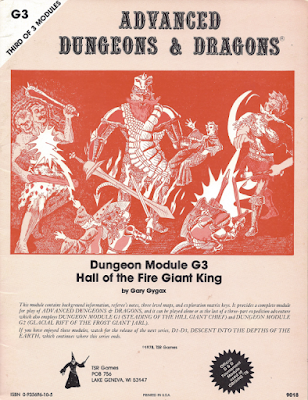 Over the years, Dungeons & Dragons has returned again and again to face its tallest foe—the giants! Most recently Wizards of the Coast pitted adventurers against them in 2016’s Storm King’s Thunder, the sixth campaign for Dungeons & Dragons, Fifth Edition, but their first appearance was in a trilogy of scenarios which began with G1 Steading of the Hill Giant Chief and continued with G2 Glacial Rift of the Frost Giant Jarl, before concluding with G3 Hall of the Fire Giant King. The three would subsequently be collected as G1-2-3 Against the Giants, which itself would form the first three parts of the campaign that would be collected in 1986 as GDQ1–7 Queen of the Spiders. In 1999, these three modules would be reprinted as part of the Dungeons & Dragons Silver Anniversary Collector’s Edition boxed set and more properly revisited in Against the Giants: The Liberation of Geoff. It would be followed in 2009 by Revenge of the Giants, the first ‘mega-adventure’ for Dungeons & Dragons, Fourth Edition, and then of course, in 2016 with Wizards of the Coast’s Storm King’s Thunder. For anyone interested in reading or running the series for themselves, G1-3 Against the Giants is available as a surprisingly inexpensive reprint.
Over the years, Dungeons & Dragons has returned again and again to face its tallest foe—the giants! Most recently Wizards of the Coast pitted adventurers against them in 2016’s Storm King’s Thunder, the sixth campaign for Dungeons & Dragons, Fifth Edition, but their first appearance was in a trilogy of scenarios which began with G1 Steading of the Hill Giant Chief and continued with G2 Glacial Rift of the Frost Giant Jarl, before concluding with G3 Hall of the Fire Giant King. The three would subsequently be collected as G1-2-3 Against the Giants, which itself would form the first three parts of the campaign that would be collected in 1986 as GDQ1–7 Queen of the Spiders. In 1999, these three modules would be reprinted as part of the Dungeons & Dragons Silver Anniversary Collector’s Edition boxed set and more properly revisited in Against the Giants: The Liberation of Geoff. It would be followed in 2009 by Revenge of the Giants, the first ‘mega-adventure’ for Dungeons & Dragons, Fourth Edition, and then of course, in 2016 with Wizards of the Coast’s Storm King’s Thunder. For anyone interested in reading or running the series for themselves, G1-3 Against the Giants is available as a surprisingly inexpensive reprint.Much of this history as well as critical response to both the individual dungeons and the collected G1-2-3 Against the Giants is detailed on Wikipedia. This is worth taking the time to read, so Reviews from R’lyeh recommends doing so before returning to this series of reviews. The ‘Giants Review’ series began with G1 Steading of the Hill Giant Chief, continued with G2 Glacial Rift of the Frost Giant Jarl, and brings the original trilogy to a close with G3 Hall of the Fire Giant King.
G3 Hall of the Fire Giant King is a direct sequel to G1 Steading of the Hill Giant Chief and G2 Glacial Rift of the Frost Giant Jarl. In G1 Steading of the Hill Giant Chief, the Player Characters were directed to investigate the recent attacks upon the lands of the humans—nominally in the World of Greyhawk—by attacks by giants of various types. Against this unheard of occurrence the rulers of these lands hired the Player Characters to deal a lesson to the Hill Giants. In the course of the adventure, the party carried out a strike—and ‘strike’ is the right term—on the Hill Giant steading, because G1 Steading of the Hill Giant Chief is nothing more than a commando raid upon a ‘military’ base. As well as discovering the presence of other giants at a feast held in their honour, what the Player Characters also discover is the scenario’s singular link to G2 Glacial Rift of the Frost Giant Jarl. It is both figuratively and actually a link, capable of transporting the party to the Glacial Rift of said second scenario. At the end of G2 Glacial Rift of the Frost Giant Jarl, the players characters find a similar link which gets them to Muspelheim, in front of the great obsidian valve-like doors of King Snurre’s halls which make up G3 Hall of the Fire Giant King.
From the outset, G3 Hall of the Fire Giant King is very different in terms of tone and presentation. The scenario is longer—at sixteen pages, double the length of G1 Steading of the Hill Giant Chief and G2 Glacial Rift of the Frost Giant Jarl—and presents three levels rather than two. It is also wrapped in a triple-gatefold cover than the double one of the previous two scenarios. Where G2 Glacial Rift of the Frost Giant Jarl was fog and ice over bare rock, G3 Hall of the Fire Giant King consists of a three hundred foot tall, smoking slag heap, its halls and rooms of black and brown worked rock, its special rooms of obsidian and black marble, all lit with torches, braziers, jets of natural gas, and even pools of molten lava. The inhabitants, predominately the Fire Giants, are warier and cannier, better reacting to intruders—more so if the player characters make multiple sorties into the halls. Notably though, unlike in the first parts of the trilogy where the big bosses are placed at the end of the scenario, the likelihood is that the player characters will encounter Snurre, the black-armoured, orange tusked and bewhiskered, bandy-legged, and ugly King of the Fire Giants, along with his bodyguards, very early on in the dungeon. They are literally found in the dungeon’s third room and a careful party could get inside and deal a mighty blow to the Fire Giants and their mysterious backers before anyone can react by killing King Snurre. That though, still leaves his even uglier and wartier wife, Frupy, and a lot of angry Fire Giants. On the other hand, the Fire Giants will react quickly to any intruders and the adventurers could find themselves forced to retreat very quickly. As with G1 Steading of the Hill Giant Chief and G2 Glacial Rift of the Frost Giant Jarl, a handy bolthole is described at the beginning of the scenario should the player characters decide they need to beat a hasty retreat.
With what is essentially the ‘reception room’ upfront, the areas beyond are given over to communal and private quarters, barracks, storage, guest chambers, and the like. Amongst the more mundane locations, E. Gary Gygax gets to write some interesting set pieces. These include the eerie Hall of Dead Kings—the crypts of the Fire Giant Kings, a smithy heated by molten lava, a torture chamber, and the Temple of the Eye—actually in use as opposed to the strange temple all but abandoned below the Steading of the Hill Giant Chief—where the Drow conduct ceremonies to some unnamed elder god. Some of these encounters veer between incredibly deadly to deadly and silly, though are horrifically weird. The fact that the King’s Torturer can throw a player character into an iron maiden and slam the door shut—killing them instantly, and the Royal Headsman can lop of heads and limbs aplenty with little recourse from the player characters point to just how deadly the adventure is. The silly is the fact that G3 Hall of the Fire Giant King repeats the error of G2 Glacial Rift of the Frost Giant Jarl by shoving a very large and ancient Red Dragon atop a huge mound of coins and other treasures into a tiny cavern. This is compounded by the addition of an illusion of a Red Dragon in the adjacent, much larger cavern. It goes against the whole sense of naturalism which permeates the rest of the scenario.
The weird includes the Temple of the Eye and its priests’ quarters. The temple is all unease and a sense of foreboding, swirling lights, purple stone, rusty black mineral block altar, and malachite pillars, where the player characters’ meddling is likely to either kill them, send mad, enrage them, age them, and so on, or under the right—potentially terrible—circumstances grant them just what they need. The quarters of the Drow priests is protected by a Wall of Tentacles, a horrid spell which will reach out with tentacles and beaks to bite, abrade, and constrict those forbidden to pass through it.
The last and third level is entirely different. Rather than worked or polished stone, it consists of natural caverns and is populated by a range of monsters more suited to the environment—Ropers, Piercers, Lurkers, and the like—although in a relatively small area. However, it is currently occupied by a number of visiting forces. These include the Drow, divided between forces divided between Eclavdra and Nedylene, the latter and her forces not only stuck out of the way, but hemmed in by a group of Mind Flayers, also monitoring Drow activities near the service. Beyond the third level itself, a tunnel leads off into the depths...
Then there are the Drow themselves—the existence of which is the big reveal in G3 Hall of the Fire Giant King. Famously, this is their first appearance in Advanced Dungeons & Dragons, and the end of the module includes their full write up as if they had been included in the Monster Manual. This feared, even infamous, Race of Dark Elves has continued to feature in Dungeons & Dragons ever since, but here they remain mysterious and intriguing. The contingent in and below the Hall of the Fire Giant King is led by the warrior-priestess Eclavdra, many of them wielding a new magic item, Rod of Tentacles.
In terms of plot, G3 Hall of the Fire Giant King is rather hit and miss. There are links to the wider plot in the correspondence found in the Council Room, including instructions given to King Snurre by the mysterious ‘Eclavdra’ about bring together various other species, including Ogres, Orge-Magi, Cloud Giants, and other in readiness to attack the lands of civilised Humans, Dwarves, Elves, and so on. In these scrolls is the first mention of the ‘Drow’, the allies of—or rather the power directing the Giants. Perhaps one of the best links to the wider plot is that rooms in the Halls of the Fire Giant King are potentially put aside for the Frost Giant Jarl and his wife and Chief Nosnra and his wife—that is, if they survived the events of G1 Steading of the Hill Giant Chief and G2 Glacial Rift of the Frost Giant Jarl respectively. Its inclusion not only points to the wider involvement of the Hill Giants and the Frost Giants, it points to the effect that the player characters have had on the ongoing campaign. In other words, that both Hill Giant Nosnra and the Frost Giant Jarl and their respective wives are there because of the player characters. Another really nice touch is that Queen Frupy actually has a Potion of Giant Control for using on her husband, Snurre!
Yet in other places, plot within the scenario is either sorely underdeveloped or overused. Not once, not twice, but four times NPCs in the scenario are subject to ‘Curse your inevitable betrayal’ plot lines. There is Ombi, the Dwarf who was once Snurre’s slave, but is now his advisor; there are three Rakshasas—who even King Snurre distrusts, but who the player characters we are told, are sure to see as “…trusted friends and associates”; a Human female Thief, who will help out before running off with any loot she can—including that stolen from the player characters; and Boldo, King Snurre’s former lieutenant who will do anything to get back in his majesty’s good books despite having been locked up for his lack of deference. All four will eventually betray the player characters should they be prepared to befriend them, though the Dungeon Master will need to determine exactly who the Rakshasas look like and what they want as no advice is given to that end. Similarly, the Titan NPC who will ally with the player characters—and the only potential ally who not actually portray them—is left up to the Dungeon Master to develop in terms of personality and motivations.
However, what this does means is that there are much stronger roleplaying elements in G3 Hall of the Fire Giant King than there are in the first two part parts of the trilogy. Most of this will be with the various traitorous NPCs already mentioned, of whom Obmi is the most notable given that he would appear again in E. Gary Gygax’s work on the World of Greyhawk as the ‘Hammer of Iuz’ and as a villain in Gygax’s Gord the Rogue novels. Then there is obvious rivalry between Eclavdra, the envoy to the surface world from below, and Nedylene, the Drow sent to check up on her. Neither NPC is really developed and again, this is left up to the Dungeon Master to handle.
In terms of the overall plot, G3 Hall of the Fire Giant King both delivers and disappoints. Yes, there is the big reveal about the power behind the hostile activities of the giants on the surface world—the Drow, and there is no denying the impact of that. However, no information is given and again, another tunnel or exit leads off to the next part of the campaign, which at this point feels like it should be complete with the publication and play through of G3 Hall of the Fire Giant King. The next part is, of course, D1 Descent into the Depths of the Earth and so it is actually far from being complete.
G3 Hall of the Fire Giant King is rewarding in terms of the treasure that the player characters will be able to carry away from its halls and caverns. In comparison to their lesser brethren in the earlier modules, the Fire Giants are rich. Most carry gems about their person, but both King Snurre and Queen Frupy have much, much more. Some of this though, is locked up in vaults and even then, hidden. Often the player characters will find it challenging to uncover it, whilst getting back to the civilised presents a whole other set of problems...
For all that G3 Hall of the Fire Giant King describes the Fire Giants as being tough opponents, and able to cleverly react to the intrusion by the player characters, the advice on how they react is underwritten. With the Throne Room and both the quarters of King Snurre and Queen Frupy so close to the entrance of the hall, there is the possibility that either or both of them are killed early on in the player characters’ sorties into the Fire Giant lair. What happens then? How do the survivors react? Given that the purpose of the scenario for the player characters is as the module states, “…to slay fire giants and all who associate with them.”, why is there so little advice to help the Dungeon Master here? Now of course, this is an ‘Old School’ module and yes, that means that the Dungeon Master is left to decide these things for herself, and whilst that is intentional, it leaves the Dungeon Master with a lot of variables to work through when preparing the adventure.
Physically, G3 Hall of the Fire Giant King is again a slim booklet, but sixteen pages rather than eight. Again, the booklet is cramped, but E. Gary Gygax again packs in a lot of detail, especially in the descriptions of Queen Frupy, of King Snurre’s vaults, Ombi and his quarters, the Temple of the Eye, and so on. The maps are generally clear and benefit from being across three levels rather than two. Unfortunately, the artwork is mostly terrible. In fact, the best piece of artwork is Dave Trampier’s profile portrait of King Snurre himself.
—oOo—
G3 Hall of the Fire Giant King was published at a time when there were few magazines in which they could be reviewed. In many cases, G3 Hall of the Fire Giant King would be reviewed when it was published in the collected G1-2-3 Against the Giants in 1981. For example, this is the version that Anders Swenson reviewed in Different Worlds Issue 20 (March 1982). He wrote of G3 Hall of the Fire Giant King that, “The fire giants live in a well-constructed dungeon complex inside a volcanic mountain. This is simply a tough nut for the adventurers - the giants are in a place constructed for defense where they can repel a sortie with secondary positions, impromptu barricades, and ambushes. The designer expects this tobe a running battle.”
White Dwarf was the exception and managed to review the trilogy of G1 Steading of the Hill Giant Chief, G2 Glacial Rift of the Frost Giant Jarl, and G3 Hall of the Fire Giant King together in Open Box in White Dwarf Issue No. 9. However, this did not mean that they were reviewing independently of each other, the late Don Turnbull concluding, “In summary, there are three D&D scenarios which have been very carefully planned in considerable detail, both individually and collectively; they have been presented in exemplary fashion and are fit to grace the collection of the most discerning. They require skill in play (which is right) but also require a party of high-level characters, and my one regret is that they were not aimed at parties more likely to be readily available to players (though, in fairness, you can't expect a weak party to take on gangs of Giants). No DM should be without them, for even if he never gets a chance to run them, they are a source of much excellent design advice.”
However, G3 Hall of the Fire Giant King was reviewed separately in Space Gamer Number 44 (October, 1981) by Kurt Butterfield. He wrote that, “The scenario is well thought out and nicely detailed. DMs will find some intriguing special instructions given for deviously playing several of the intelligent inhabitants of the dungeon. There’s also some useful and interesting information on the Drow (dark elves).” before continuing, “This is definitely not ab easy dungeon, and since the monsters are quite strong and numerous, players will often be hard put to survive. Many of the monsters could be left out and this would still have been a challenging adventure.” He concluded by writing, “I advise all DMs who are looking for an exciting, worthwhile adventure for their players to pick this one up. You won’t be disappointed.”
—oOo—
G3 Hall of the Fire Giant King brings the ‘G’ series of adventures to a big, challenging finale—if not necessarily a conclusion. In comparison to G2 Glacial Rift of the Frost Giant Jarl, it is undeniably a better dungeon. Perhaps not quite as atmospheric, but better and more interesting in terms of individual locations, plotting, and roleplaying potential. Unfortunately, neither the plotting nor the roleplaying potential is as developed as it should be, that is, sufficiently enough to be helpful to the Dungeon Master, and ultimately, enough to explain the reasons for what is going on between the Drow and the Fire Giants. There is though a sense of scale and grandeur to G3 Hall of the Fire Giant King, the enemies and big and tough, the halls are tall and eerie, and there is a sense of mystery to the place in uncovering just what is going on (as much as the module explains everything). Unlike G2 Glacial Rift of the Frost Giant Jarl, the dungeon in G3 Hall of the Fire Giant King does not feel as static, but much of what is going on is confined to individual locations rather than the whole complex and perhaps in as organised a place as the Hall of the Fire Giant King, the module could have done with a schedule of events to give some idea of what its various inhabitants are doing and when. Again, this something that is left up to the Dungeon Master to decide.
G3 Hall of the Fire Giant King is a big, bruising, even brutal dungeon crawl. It will take clever gameplay and tactics upon the part of the players and their characters to survive, but just like G2 Glacial Rift of the Frost Giant Jarl before it, G3 Hall of the Fire Giant King needs a lot of input from the Dungeon Master to bring out the best of its details.
—oOo—
It should be noted that Wizards of the Coast collected and published G1 Steading of the Hill Giant Chief, G2 Glacial Rift of the Frost Giant Jarl, and G3 Hall of the Fire Giant King as part of Tales from the Yawning Portal for Dungeons & Dragons, Fifth Edition. It is a pity that Goodman Games would not have a chance to revisit, develop, and update the series as it did for B1 In Search of the Unknown and B2 Keep on the Borderlands with Original Adventures Reincarnated #1: Into the Borderlands. Certainly there is some archival material in the early issues of Dragon magazine, such as the examination of these modules as tournament adventures in Dragon 19. In the meantime, the next review in the series will be of Against the Giants: The Liberation of Geoff.
Jonstown Jottings #22: GLORANTHA: Trinkets from Dragon Pass
—oOo—
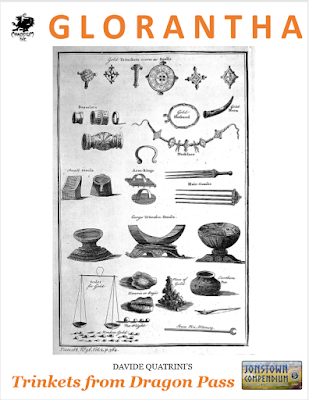 What is it?
What is it?GLORANTHA: Trinkets from Dragon Pass is a short supplement for for RuneQuest: Roleplaying in Glorantha.
It is a five page, full colour, 9.71 MB PDF.
GLORANTHA: Trinkets from Dragon Pass is decently presented and organised. It needs a slight edit.
Where is it set?
Dragon Pass.
Who do you play?
Adventurers of all types who could come across curios, novelties, gewgaws, and the like.
What do you need?
RuneQuest: Roleplaying in Glorantha. It can also be run using the RuneQuest: Roleplaying in Glorantha – QuickStart Rules and Adventure.
What do you get?
A single table with fifty entries.
GLORANTHA: Trinkets from Dragon Pass is a short—a very short—supplement containing one table. On this table is listed fifty entries listing gewgaws and trinkets and curios and knickknacks that you could find amongst an NPC’s personal possessions. For example, “A bronze clasp, once belonging to the belt of a fierce Orlanthi fighter. It resembles the head of a trollkin.” or “Something which resembles a brass bracelet, but it is instead a decoration for the central horn of a triceratops domesticated by dragonewts.” Some of them are even ever so slightly magical, such as “A miniature wicker boat. When a copper Clack is put in it, a faint, illusory image of Jeset the Ferryman appears for a moment.”
Is it worth your time?
Yes. GLORANTHA: Trinkets from Dragon Pass is an inexpensive way of adding verisimilitude to your RuneQuest: Roleplaying in Glorantha campaign.
No. GLORANTHA: Trinkets from Dragon Pass is simply too expensive and does not offer enough value for money for what you get, plus the small details do not always matter.
Maybe. GLORANTHA: Trinkets from Dragon Pass is expensive for what you get, but who knows what you might find packed away on that Issaries merchant caravan?
Have a Safe Weekend
The Future of BECMI and Black Box Basic
But that was not the end of "Basic" or BECMI D&D. I reviewed into the Maelstrom yesterday and talked about how it had a real proto-90s feel even in 1985. So let's look briefly into the future of the D&D Basic line to see what the 90s has in store.
In 1991 TSR was a very different place than when Gygax and Co. set out to create a new kind of game. Most, if not all, of the old guard, were gone. AD&D 2nd Edition was the house game of choice and the order of the day were the worlds and settings created for it.
At some point, and I have no insight on this, a new version of the D&D game was introduced. Like the previous games it was in a box and contained some basic information. Unlike those previous games, this box was more like a board game box, the levels went from 1 to 5, and there were maps, dice, and game pieces included.
The New Easy to Master Dungeons & Dragons Game (1991)This new "Basic", sometimes called "Black Box Basic" was a new attempt at an introductory set of rules for D&D.

The design is by Troy Denning and the rulebook was written by Timothy B. Brown.In what is sure to be a blow to old-school purists, Gygax, Arneson, and Mentzer are never mentioned in the book. To add insult to injury Lorraine Williams is given a special thanks.
Outside of that and the gimmick of the boardgame style box the rules inside are very clean, easy to read and understand and play with. Obviously, these rules are drawn from the BECMI core and this set is designed to be an introduction to the D&D Rules Cyclopedia.
The box itself is a treasure trove, to be honest.

The rule book for players is quite attractive.

Dice, card stock characters and monsters, and a 1991 TSR catalog.

Zanzer's Dungeon. The map is really nice and scaled for 1" = 5', so compatible with D&D 3.x, 4e and 5e.

DM's Screen and book.

The underside of the box displaying all the pieces.

A 1991 TSR catalog for the D&D line. Let's have a better look at that Rules Cyclopedia...

Someone will have a cover mocked up of this by next week I am sure.

The DMs Guide and screen with the Players Book. Both came in the Basic set and The Dragon's Den boxed set.




There were also three add-ons, called "Adventure Pack" for this. I only own The Dragon's Den and it has pieces that compliment the Basic set. The DM's Guide/Screen and Player's Book are included in both. All three are available on DriveThruRPG, but they are not as complete as the physical products.



Although reading online I can't confirm if the Rule Book and the DM's Guide/Screen actually came with the Dragon's Den.
This is the future for the D&D line until the end of the decade.

Yes, that is the Rules Cyclopedia PoD. Here they are all together.

When I decide to run a new Basic-era campaign (instead of a bunch of one-shots) I am going to be overwhelmed with choices.
Leagues of Gammerstangs
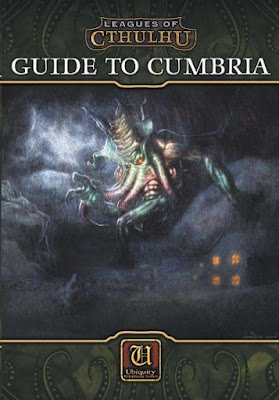 As the title suggests, Leagues of Cthulhu: Guide to Cumbria is a supplement for use with both Leagues of Cthulhu, the supplement of Lovecraftian horror for use with Leagues of Adventure: A Rip-Roaring Setting of Exploration and Derring Do in the Late Victorian Age! and its expansion, Leagues of Gothic Horror. Published by Triple Ace Games, it presents a guide and a gazetteer to the English county of Cumbria in the Late Victorian Era, not just the history and the geography, but the Mythos and the folklore, and more. Although it is not a comprehensive guide—being relatively short at just thirty-two pages—it presents more than enough information to bring a campaign to England’s North-West, whether a supernatural campaign for Leagues of Adventure or a Lovecraftian investigative horror campaign for Leagues of Cthulhu. In addition, what few stats there are for use with the Ubiquity system are easy to interpret and adapt to the system of the Game Master’s choice, whether that is Cthulhu by Gaslight for Call of Cthulhu, Seventh Edition, Trail of Cthulhu, or even Liminal.
As the title suggests, Leagues of Cthulhu: Guide to Cumbria is a supplement for use with both Leagues of Cthulhu, the supplement of Lovecraftian horror for use with Leagues of Adventure: A Rip-Roaring Setting of Exploration and Derring Do in the Late Victorian Age! and its expansion, Leagues of Gothic Horror. Published by Triple Ace Games, it presents a guide and a gazetteer to the English county of Cumbria in the Late Victorian Era, not just the history and the geography, but the Mythos and the folklore, and more. Although it is not a comprehensive guide—being relatively short at just thirty-two pages—it presents more than enough information to bring a campaign to England’s North-West, whether a supernatural campaign for Leagues of Adventure or a Lovecraftian investigative horror campaign for Leagues of Cthulhu. In addition, what few stats there are for use with the Ubiquity system are easy to interpret and adapt to the system of the Game Master’s choice, whether that is Cthulhu by Gaslight for Call of Cthulhu, Seventh Edition, Trail of Cthulhu, or even Liminal.(Note: ‘Gammerstang’ means awkward person in the local dialect.)
Leagues of Cthulhu: Guide to Cumbria details an area of the north of England, bordering Scotland, which is best known as the Lake District—for the lakes Windermere, Coniston Water, Ullswater, Buttermere, Grasmere, and many others, and as the home of the ‘Lake Poet School’ whose members included William Wordsworth, Samuel Taylor Coleridge and Robert Southey. Since the Victorian period it has been primarily been seen as a tourist destination, but prior to that, it was a source of worked-flint, a frontier of the Roman Empire, a frontier region between England and Scotland, a rural backwater, and more recently, with the coming of the railways, an industrial centre. Yet in ages past, races of the Mythos like the Elder Things and the Fungi from the Yuggoth operated in the region, whilst with the coming of mankind, the Deep Ones migrate to the Cumbrian coast and begin interacting with them. The Celts brought worship of the Shub-Niggurath and avatars of Nyarlathotep to the region, whilst the Romans also imported the worship of dark gods from the far edges of their empire.
Now despite its title of Leagues of Cthulhu: Guide to Cumbria, the supplement actually describes not the county of Cumbria as it is today—which only dates from 1974—but rather Cumberland, Furness, and Westmoreland. (For ease of play, the supplement simply uses Cumbria.) It covers the region in three chapters. The first of these introduces the area and gives its history, geography, a guide to getting there and what to find when you do, the latter including cuisine, entertainment, policing, and so on. The inclusion of a guide to toponyms—Cumbrian place names, the local dialect, folk remedies, and general superstitions all add a pleasing degree of verisimilitude. In game terms, it suggests various Leagues of Adventure faculties to be found in the region, for example, the Anglers’ Club, Bath Club, Mariners’, and Society of Aquanauts share a clubhouse in Bowness-on-Windemere. (The presence of the latter a knowing nod—backed up by an even more nod to The Private Life of Sherlock Holmes.)
The second chapter is the gazetteer and forms the heart of the supplement. It covers ancient sites, natural features, Roman sites, and settlements, many of which are accompanied by adventure seeds. Thus, the Castlerigg Stone Circle outside of Keswik, whose number of stones is said to be uncountable and at the centre of which is a firepit which when unearthed was a blob of “some dark unctuous sort of earth.” The adventure seed for this suggests that this was the remains of a Black Spawn of Tsathoggua. The natural features include the region’s various caves and lakes, the Roman sites two major forts in the area, whilst the settlements cover its towns and villages, from Ashness Bridge and Aspatria to Whitehaven and Workington. It describes the Dacre family, a prominent Cumbrian family which in the past was split between its worship of Cthulhu and Shub-Niggurath, and supports this with a new Bloodline for Leagues of Cthulhu. Tying back to the Lakeland poets and Samuel Taylor Coleridge, a notable narcotic ‘Kendal Black Drop’ of the period, better enables users to enter the Dreamlands or simply opens them to the thoughts of the Great Old Ones…
The third chapter presents denizens of the region. They include lists of dignitaries—aristocrats, bureaucrats, clergymen, and Members of Parliament—all names which Game Masters and Keepers will want to research before bringing into their campaigns. The only famous person fully detailed is the bon vivant Earl Lonsdale, known as the ‘Yellow Earl’ for his favourite colour. This may or may not signify something… Lastly, the supplement details a cult, the Brotherhood of the Maimed King. Linked to Arthurian myth, this is horridly both fecund and bucolic and is the content in the book which is probably the easiest for the Game Master and the Keeper to develop into a scenario.
Physically, Leagues of Cthulhu: Guide to Cumbria is a plain affair. It is simply laid out, there are no illustrations, and there are no maps. The latter is more of an issue than the former, forcing even the most casual of readers to do some research to give context to places and features described in the text. That said, any good Game Master or Keeper will probably do more research if she is going to run a scenario or take her campaign to Cumbria, so maps are not as much of an issue as they could be. Still, it would have been nice if there had been one included.
Anyone coming to Leagues of Cthulhu: Guide to Cumbria expecting the Mythos to be running wild across the rolling hills, up and down the fells, along the long the deep valleys of the region, conspiracies of worshippers working to bring about some grand plan to end the world, will be disappointed. Leagues of Cthulhu: Guide to Cumbria is not that supplement. It is broader in its over overview of the region, encompassing the supernatural as well as the Mythos, but layering it under folklore and myth and superstition. What manifestations of the Mythos there are in Cumbria are holdouts, relics from the ancient past, perhaps best left to linger and die off rather than arise again due to some meddling from all-too inquisitive Globetrotters or investigators. Anything in Leagues of Cthulhu: Guide to Cumbria will need some development upon the part of the Game Master or Keeper to turn into a full mystery, but is still worth keeping on the shelf as reference or just in case the Globetrotters or investigators feel like a holiday in Wordsworth country.
Review: M1 Into the Maelstrom (BECMI)
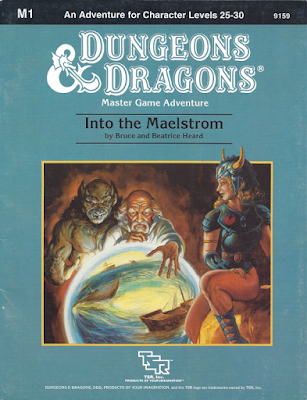 In some ways, I do wish I had read M1 before I had picked up M3. I had picked both modules up around 10-13 years ago while looking for a good epic level adventure for my kids then D&D 3.x game. They were into the epic levels of D&D 3, with the lowest level at 24 and the highest at 29. They were on this huge campaign against what they thought was the machinations of Tiamat. M1 was very good choice since I love the idea of flying ships (D&D should be FANTASTIC after all) but the base plot didn't work for the adventure in mind. M3, along with some other material, worked rather perfectly. Plus I can't deny that the Carnifex played a huge role. So M3 went on the table and M1 went back on the shelves.
In some ways, I do wish I had read M1 before I had picked up M3. I had picked both modules up around 10-13 years ago while looking for a good epic level adventure for my kids then D&D 3.x game. They were into the epic levels of D&D 3, with the lowest level at 24 and the highest at 29. They were on this huge campaign against what they thought was the machinations of Tiamat. M1 was very good choice since I love the idea of flying ships (D&D should be FANTASTIC after all) but the base plot didn't work for the adventure in mind. M3, along with some other material, worked rather perfectly. Plus I can't deny that the Carnifex played a huge role. So M3 went on the table and M1 went back on the shelves.Until that is Bruce Heard began producing material for Calidar.
M1 Into the Maelstrom is really a fantastic adventure for the D&D Master's Set that realizes that set's potential. It is also a great lead-in to not just the Immortals Set coming up, but also the future of the Mystara-line and even pre-sages Spelljammer and the adventures of the 90s. Additionally, and somewhat forgotten, this book introduces us to our first named Immortals and introduces demons to BECMI.
There is a lot going on here. Let's get into it.
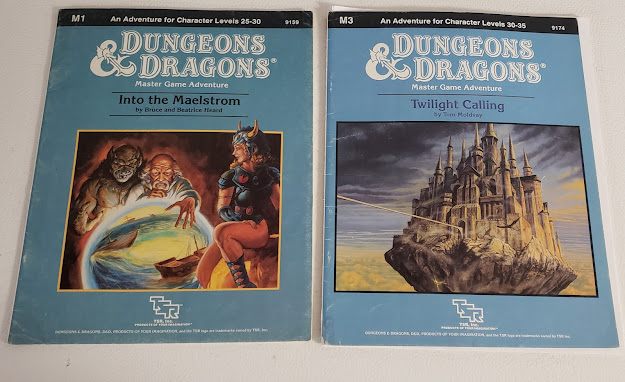
For this review, I am going to consider my original print module and the PDF from DriveThruRPG. There is a Print on Demand version as well, but I do not have it.
M1 Into the MaelstromBy Bruce and Beatrice Heard. 32 pages, color covers, black & white interior. Cover art by Jeff Easley, interior art by Valerie Valusek and maps by Dave "Diesel" LaForce.Into the Maelstrom deals with the machinations of three Immortals, Koryis (Law), Vanya (Neutral) and Alphaks (Chaos), and are featured on the cover. Alphaks is our focus here. He is the focus of the next few adventures and is one of the "Big Bads" of the later BECMI and Mystara lines. He was the ancient Emperor of Alphatia AND he is the first demon we see by the name demon in any BECMI book to my knowledge. He is a "Roaring Demon" or what 1st Edition calls a Type VI or Balor demon. We won't learn more about them till the Immortal set, but here they are. Demons in Basic D&D.
Our adventure starts in the Known World. We bring back King Ericall of Norwold and he needs the characters to investigate the source of some poisonous winds coming from the north between Norwold and the Island Empire of Alphatia (to the east). The poisonous fog/winds are the result of Alphaks trying to reenter the world via a two-way portal from the Sphere of Death (call back to Death's Ride!)
The three immortals are essentially playing a game. Alphaks wants into the world, Koryis doesn't want him in and Vanya is going to side with the winner. As the adventure progresses each immortal will earn points for the actions, successes and/or failures of the PCs. The DM keeps track. The PCs can also gain curses or boons as the adventure continues.
So another new addition is the "Sea Machine" or water-based battles as an addition to the War Machine. Pretty nice bonus add if you ask me.
The first part of the adventure goes pretty normal. That is until the seagoing vessels encounter the titular maelstrom. The PCs are sucked into the swirling vortex of death and spit out into a starry void with air they can breathe! How's that for adventure?
Here this becomes a proto-Spelljamming adventure, there are several locations (Islands) that the PCs can stop at, but each has their own unique set of hazards.
The PCs must navigate, in all senses of the word, the machinations of these three immortals. There is even a giant battle with a navy of the dead controlled by Alphaks.
In addition to the new monster stats (the Roaring Demon), there are PC/NPC stats in back for characters to use in the adventure.
So for the first time, we get a BECMI adventure into the other planes. Here the characters get a chance to travel the outer planes via a flying ship and even dip a toe into the Astral plane. Depending on the outcome the characters can also be set on the path to Immortality.
This adventure is "bigger on the inside" as has been described. There is a lot here that can be expanded on to a near-infinite degree. With a ship that can transverse the planes a good argument could be made about even returning to the Known World and Norwold.
Let's also take a moment and talk about Diesel LaForce's maps.
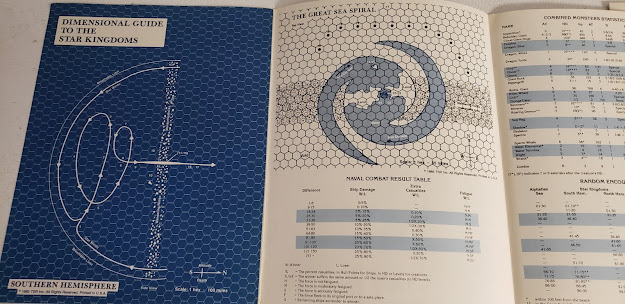
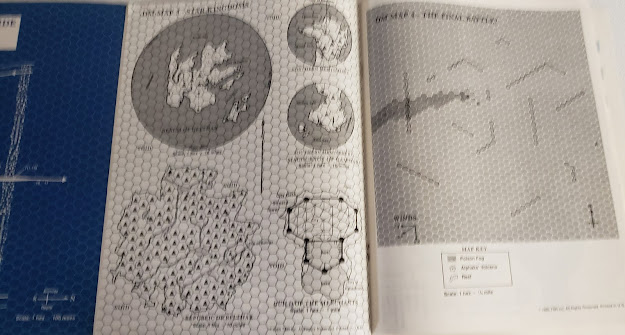
These things are works of art really. I am not sure how as a DM you can look at them and NOT want to run this adventure. "Dimensional Guide to the Star Kingdoms?" Hell yeah!
Into the Maelstrom, along with the other modules in the M series work not just as a Master's level set of adventures, but also our introduction to plane hopping and dealing with immortals in the D&D game. Compared to the same treatments in AD&D, such as the H Series, the M series is more subtle in it's approach. The H series is largely about kicking in doors, killing monsters and taking their stuff. Only in the H series, the doors are planes, the monsters are gods and demons and their stuff are artifacts.
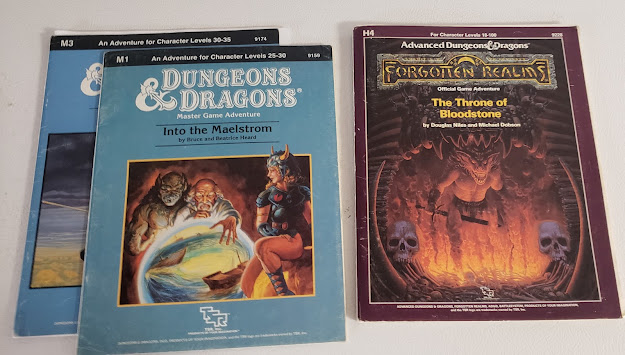
Going back to the beginning, if I had known more about the arc (let's call it the "Norwold Saga") then all of these adventures do tie into all the others in a nice, dare I say it, Adventure Path. Maybe that is something that WotC could do to reintroduce Mystara is give us this for 5e rules.
Keep in mind that this "Adventure Path" or even meta plot was alive and well in the mid-80s. Long before the 90s that this sort of gaming is most associated with. I might have to explore this idea further.
In the meantime, M1 Into the Maelstorm stands out as not only a great adventure, but a groundbreaking one in many ways.
Falling Into The Sky: Disappearance, Aviation, and ‘The Twilight Zone’
Grafton Tanner / June 25, 2020
 “Really nothing there, is there?”
“Really nothing there, is there?”
—from Duck Pimples (1945)
Classic episodes of The Twilight Zone (1959-1964) follow a simple formula. An ordinary person experiences something extraordinary, and we follow along as they figure out what is happening. Very often, the story ends with a twist: the cross-country traveler has been dead all along, the aliens are actually astronauts from Earth, To Serve Man is a cookbook. But not every episode adheres to this formula. In fact, the very best of Rod Serling’s visionary series aren’t so simple.
“And When the Sky Was Opened,” from the first season, is one of the very best. Based on the Richard Matheson short story “Disappearing Act,” the episode tells the story of three pilots—U.S. Air Force Colonel Ed Harrington (Charles Aidman), Colonel Clegg Forbes (Rod Taylor), and Major William Gart (Jim Hutton)—who return from the first voyage into space only to be erased from existence, one by one. The story begins after the pilots have crash landed, but Rod Serling’s opening monologue includes a bit of crucial exposition: the pilots vanished from radar and lost all contact with mission control for twenty-four of the thirty-one hours they were in flight.
After the mysterious and sudden disappearance of Harrington upon landing, Forbes desperately tries to convince Gart that something has taken Harrington from this world, that perhaps “somebody or something made a mistake” and let the three pilots return when they shouldn’t have. Gart, confined to a hospital bed, has no memory of Harrington, and Forbes comes to realize that no one else remembers the pilot. The story ends with Forbes arriving at the horrific realization that he is next to disappear. Begging for his life, he runs screaming from Gart’s hospital room and vanishes. When the nurse fails to remember Forbes, Gart then understands the colonel was telling the truth, and Gart, the aircraft, and the mission disappear without a trace.
The episode is a success for many reasons. The acting is palpable; you can feel the existential horror of the pilots as they come to terms with their absurd fate. As the panicked Clegg Forbes, Rod Taylor gives a dynamic performance of a man splintering into madness, and when the supporting cast gawks at him with pity, you start to wonder whether Forbes is really delusional. The episode also refrains from ending with a twist. There is no grand surprise at the end, only eerie ambiguity. Something has disappeared the pilots from existence. Without a conclusive reveal, all we’re left with is a lingering cosmic horror—the bizarre, nauseating suspicion that the universe operates according to unknown logic. Perhaps there’s no logic at all.

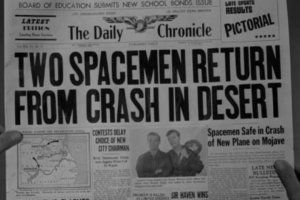

Like every Twilight Zone episode, “And When the Sky Was Opened” reflects both modern and timeless human anxieties. It can tell us quite a bit about memory and information loss, about the politics of disappearance both in postwar culture and in today’s time of social amnesia, when too much information inevitably causes some things to be remembered and others to be forgotten. And the episode uses aviation to reveal the politics of social forgetting, exposing the truth that only those who remember the past disappear.
“And When the Sky Was Opened” is not the only Twilight Zone entry to feature disappearing aircraft. The third season also-ran “The Arrival” tells the story of a commercial flight that lands mysteriously without anyone on board. A detective with a perfect record is assigned the case, and he slowly comes to believe the plane isn’t real. When he attempts to prove this by placing his hand in the path of a spinning propeller, the plane vanishes. The twist? The detective does not actually have a perfect record. In his entire career, there was only one case he couldn’t solve: a missing airplane that disappeared mid-flight years earlier. The empty plane is merely a ghost that has come back to torment him. And in the brilliant “The Odyssey of Flight 33,” a routine flight encounters a strange tailwind that accelerates it past the speed of sound. When the plane slows, the pilots attempt a landing—only to realize they have traveled backwards in time to some prehistoric era. They successfully pick up the tailwind again, hoping to travel back to the present. This time they stop in 1939. The episode concludes with the pilots preparing to ride the tailwind back to the present one last time before the plane runs out of fuel.
“Now, most airplanes take off and land as per scheduled,” Rod Serling reminds us in his opening to “The Arrival.” “On rare occasions, they crash. But all airplanes can be counted on doing one or the other.” Except when they don’t. Serling wrote Twilight Zone plots around vanishing airplanes because he knew they shake our faith in a thinkable world. How can something so huge and with so many people involved simply vanish?
***It’s a question asked in the wake of every major aviation mystery, from Flight 19 to the recent disappearance of Malaysia Airlines Flight 370. The commercial flight took off from Kuala Lumpur International Airport and headed to Beijing on March 8, 2014. It never landed. Shortly after takeoff ATC lost contact, and the plane, with its 239 people on board, disappeared from radar. The search for it became the most expensive in aviation history, but nothing was found. Some say it crash landed; others have speculated it was hijacked. There is no consensus among investigators.
James Bridle calls aviation a “site where technology, scientific research, defense and security interests, and computation converge in a nexus of transparency/opacity and visibility/invisibility.” But it’s more than that. For over a century, aviation has been the engine of information science, as well as the proof that once-impossible dreams can come true with the help of mighty computing power. Along with the realization of human flight came unprecedented connectivity, which in turn caused an explosive outbreak of information: projections, predictions, models, and data. Over the twentieth century, technology progressed at a dizzying rate. Planes, along with everything else, got faster. “At such an exponential rate,” David Graeber writes, “it must have seemed reasonable to assume that within a matter of decades, humanity would be exploring other solar systems.”
And then something strange happened. Technological advancement slowed in some areas, and planes were no longer quite as fast. While aviation slowed, however, information science did not. Today, futurity is measured not by the speed of an airplane but by the speed of WiFi. A technology today seems futuristic if it provides us with a steady drip of information, of which there is more than could ever be analyzed by anyone. The so-called infodemic—a viral outbreak of information and misinformation—did not start with the 2020 outbreak of COVID-19. It’s been ongoing since the birth of the information age, and it’s only gotten worse.
Without aerospace science, funded largely by the military, there would be no information age, for aviation is only possible via advanced information technologies. The disappearance of planes, such as Malaysia Airlines Flight 370, proves that information can vanish too—a shocking truth almost too horrible to bear in our control society. “For everything that is shown,” Bridle writes about plane-tracking, “something is hidden.”
 Information loss is a natural occurrence, and it’s especially prevalent—and dreadful—in a society obsessed with eliminating unknowns. But sometimes, disappearance is artificially induced to serve certain interests. Ideas that challenge ruling ideologies, the ones that resist capital especially, are erased. Memories of radical events are written out of history, consigning non-normative knowledge to the margins—very often deleting them from the official account altogether. If they do survive, traces of these events hunker underground, or they hide beneath the cover of normativity, passing as “appropriate” but occasionally winking from behind the veil at those who also know. If they are eradicated, stamped out of the cultural script, radical memories will always return as ghosts, terribly inconvenient reminders of an alternative future that was foreclosed by capitalism. This act of hauntology, of the forgotten past haunting the present with visions of lost futures, is crucial for collectives to combat the neoliberal “eternal” present—if only we could remember.
Information loss is a natural occurrence, and it’s especially prevalent—and dreadful—in a society obsessed with eliminating unknowns. But sometimes, disappearance is artificially induced to serve certain interests. Ideas that challenge ruling ideologies, the ones that resist capital especially, are erased. Memories of radical events are written out of history, consigning non-normative knowledge to the margins—very often deleting them from the official account altogether. If they do survive, traces of these events hunker underground, or they hide beneath the cover of normativity, passing as “appropriate” but occasionally winking from behind the veil at those who also know. If they are eradicated, stamped out of the cultural script, radical memories will always return as ghosts, terribly inconvenient reminders of an alternative future that was foreclosed by capitalism. This act of hauntology, of the forgotten past haunting the present with visions of lost futures, is crucial for collectives to combat the neoliberal “eternal” present—if only we could remember.
When American soldiers returned from World War II, they came back bearing secret knowledge: the horrors of warfare and the absurdity of power. Waking up as civilians, the returned had their memories wiped by the burgeoning postwar consumer society, which promised pleasure through purchasing and fixed gender roles as binary, locking into place a suffocating bureaucratic rationality that extended from the corporate sector to the body. Like the pilots in “And When the Sky Was Opened,” those who remembered had to disappear for the postwar dream to persist. Rod Serling served in WWII and witnessed the carnage of war firsthand in the Philippines. He grew familiar with the randomness of death during his service. He saw a fellow private decapitated by a falling food crate while telling a joke. The collision of comedy and death stunned Serling, who was eventually awarded the Purple Heart but experienced difficulty returning to civilian life—how far removed it was from war’s chaos. To cope, he filtered his knowledge through the medium of television, encountering fierce resistance from studio executives as he created The Twilight Zone, itself an indictment of unbridled power disguised as a fantasy series.
By the time Serling died in 1975 from a series of heart attacks, Augusto Pinochet was forcefully disappearing thousands of political opponents in Chile. Animated by American free-market ideology, Chile began a neoliberal conversion in the 1970s, and anyone who opposed it was punished. Some were thrown from helicopters into the ocean; others simply vanished. Decades later, the United States would wage its own regime of disappearance. Conducting “extraordinary rendition” in the wake of 9/11, CIA agents abducted so-called enemy combatants, transported them to makeshift prisons, and tortured them for information about global terror cells. Forty of these combatants remain at Guantanamo Bay, a concentration camp operated by the United States. The prisoners kept there are “ghost detainees”: neither dead nor alive, liminal, in between the cogs of a ruthless penal machine beholden to no one. Their flickering presence/absence haunts the American imaginary.
Living with the knowledge that things will disappear is a dreadful existence, made all the more horrible when we understand that not all disappearances are accidental. Realizing something erased his co-pilot and lifelong friend from existence, Colonel Forbes is sick with dread. He knows that erasure is an act of historical violence. It is a singularly cruel feat to exterminate every last memory of a person, especially if they carry a truth that reveals the hideous countenance of injustice. Capitalism is a disappearing act. Work is contingent; markets, volatile. Things are stable until they aren’t—which means they never truly are. When the sky opens, only the privileged survive. Only the amnesiacs are left alive.
![]() Grafton Tanner is the author of The Circle of the Snake: Nostalgia and Utopia in the Age of Big Tech and Babbling Corpse: Vaporwave and the Commodification of Ghosts. His writing has appeared in The Nation and the Los Angeles Review of Books.
Grafton Tanner is the author of The Circle of the Snake: Nostalgia and Utopia in the Age of Big Tech and Babbling Corpse: Vaporwave and the Commodification of Ghosts. His writing has appeared in The Nation and the Los Angeles Review of Books.
Retrospective, Review and Refit: M3 Twilight Calling (BECMI)
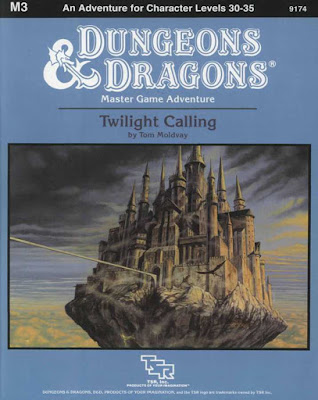 If there is an "Alpha and Omega" to my D&D games with my kids then the title could be held by Gary Gygax, but most likely the titleholder would really be Tom Moldvay.
If there is an "Alpha and Omega" to my D&D games with my kids then the title could be held by Gary Gygax, but most likely the titleholder would really be Tom Moldvay.It has been his adventures that my family have enjoyed the most.
X1 Isle of Dread (w/ David Cook)X2 Castle AmberB3 Palace of the Silver Princess (w/ Jean Wells)B4 The Lost CityA2 Secret of the Slavers Stockade (w/ Harold Johnson)
His Basic set rules are what really got me deep into D&D, maybe even more so than Holmes.
So it is really not such a surprise that when I began to look for a "Big Finale" sort of adventure my attention would turn to the Master Series.
While I initially thought that Bruce Heard's M1 Into the Maelstrom would be my choice (and it is still a fine choice, for something else I have in mind) it was quickly replaced when I discovered Tom Moldvay's M3 Twilight Calling.
Twilight Calling is actually rather perfect. It is a high-level adventure that feels like a high-level adventure. The main focus of the adventure is around a rising power among the Immortals, Alphaks the Dark. He wants to release the ancient Carnifex race (more on them in a bit) who are sealed away in an extra-planar pocket dimension. He can't do this himself, only Lawful creatures can enter the realms protecting it and thus break the seals. The adventure begins all the way back in the "Broken Lands" of the D&D Expert Set (both B/X and BECMI) but soon the characters go on an extra planar romp through the "Seven Realms" to the final location, Carnifex Castle.
The CarnifexCarnifex are an evil species akin to both lizards and dinosaurs. We get a good insight to Moldvay's Pulp sensibilities here where evil lizard men with alien brains and cold-blooded evil are the bad guys. For me, it works. Works much better than orcs or even drow. They are described as lizard-like humanoids.Not much more than that. So given the adventures I had been taking the kids through a thought occurred to me. What if the Carnifex are the progenitors of all the reptilian races of the D&D? Lizardmen, troglodytes, Yuan-Ti, and others. We learn very, very little about them in this adventure.We know that Carnifex means "butcher" in Latin. It also translates also into executioner, hangman, tormenter, murderer, scoundrel, and villain. So yeah, these are not supposed to be nice guys. This all made me think about the Silurians from Doctor Who. An ancient race related to the dinosaurs. This also made me think of the "Dinosauroid" or the "Dino Sapiens" that scientists have imagined as a humanoid descendent of the Troodon.

If you are thinking of a Sleestak you are not alone.
This is fantastic really. But for my Dragonslayers' game has no context for Alphaks the Dark. And the Carnifex really could be anything. So. How do I take this adventure and make it work for my group?
Enter The Dragon. Well The Dragon #38 to be exact.
Dawn & Twilight: Dragon 38 (1980) and M3 Twilight Calling
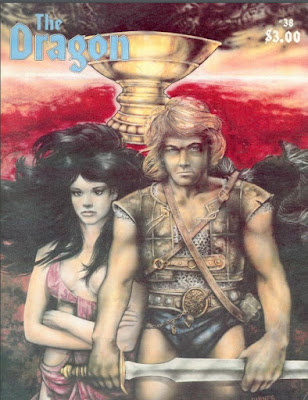 Dragon 38, still called The Dragon then, was one of those issues that are just full of great ideas. I had a copy on my Dragon Magazine CD-ROM, but I knew about it beforehand for the famous Gygax From the Sorcerer's Scroll article "Good Isn't Stupid, Paladins & Rangers." I played a lot of Paladins back then so this was a must read. BUT that article pales in comparison to what the rest of the issue gave me.In the same article it is mentioned that dwarf women have beards. Great. But I said dwarf witches do not. In fact that is the surest way to be called a witch in dwarven culture, if you can't grow a beard.There is a story from Gardner Fox, a comic by Darlene that is better looking than most of the comics in Dragon before or since. But three articles in particular grabbed my attention.
Dragon 38, still called The Dragon then, was one of those issues that are just full of great ideas. I had a copy on my Dragon Magazine CD-ROM, but I knew about it beforehand for the famous Gygax From the Sorcerer's Scroll article "Good Isn't Stupid, Paladins & Rangers." I played a lot of Paladins back then so this was a must read. BUT that article pales in comparison to what the rest of the issue gave me.In the same article it is mentioned that dwarf women have beards. Great. But I said dwarf witches do not. In fact that is the surest way to be called a witch in dwarven culture, if you can't grow a beard.There is a story from Gardner Fox, a comic by Darlene that is better looking than most of the comics in Dragon before or since. But three articles in particular grabbed my attention.Tesseracts by Allen Wells gave me some wonderful ideas for when I ran Baba Yaga's Hut and other crazy adventures. It gave me the frame of reference of how I wanted to run M3.
Leomund’s Tiny Hut: The mighty dragon by Len Lakofka gave me the hook I was looking for, though not in the way I am sure he thought it would. Len's article is a great one and it gives us out very first look at the Yellow, Orange, and Brown dragons. Brown dragons, of course, would later appear in the Mater Rules as the Chaotic counterpart to the Gold Dragon. I did a version of my own Orange dragon (really more of a Pumpkin Dragon) in my Pumpkin Spice Witch book. The Yellow Dragon then was a new one. And it fit perfectly into a hole I had. In M3 there are different color realms that all correspond to the color of a chromatic dragon; Green, Red, Black, Blue, White, and then Yellow. But no Yellow dragon. Until Len gave me one. He also has updated stats for Tiamat and Bahamut.This got me thinking. What if Aphaks was not just some rogue would-be immortal? What if he/she were a third Dragon god? The Master's set has four dragon rulers. The Forgotten Realms has more than two as well (IIRC). Or how about even a better idea. What if Aphaks was Apsu, Tiamat's "dead" consort? The Carnifex could have been his creations. The ancient evil enemy of the Dragonborn?
The Seven Magical Planets by Tom Moldvay can read a proto version of M3. This article leans more on the alchemical aspects of the seven planets, the Sun, Moon, Mercury, Venus, Mars, Jupiter, Saturn. They do not line up as well with the M3 sequence, so I might change them a bit. If I go with Babylonian/Summerian ideas then I would rename the planets to their Summerian names. Mercury with Nabu (Nebo), Venus with the goddess Ishtar, Mars with Nergal, Jupiter with Marduk, Saturn with Ninurta (Ninib), for the classical planets (and suggested by Moldvay in the article) and Sin/Nanna for the Moon and Utu/Shamash for the Sun.I am not sure if the alchemical correspondences still line up. In the end it might not matter all the much as long as the feel is right. This is a D&D game, not a Hermetic study on Alchemical principles.
So where does this leave me?
Well, long ago Tiamat reigned. She battled with the gods over her creations, the dragons. Her blood was spilled and from that the Dragonborn were created including their god Marduk. Gilgamesh in this world view was the first Dragonborn King. Enkidu was "like an animal" or human.
When the Dragonborn came into this world they encountered the evil Carnifex. They had been old even when the Dragonborn where new. They harkened back to a deep time of the world when it was a hotter place and populated by reptilian beasts and eldritch horrors. Their wars were long and bloody and they could only defeat them by sealing them up in a demi-plane of imprisonment. I posted about this in my Dragonborn in Oerth.
I have an evil, or at least corrupt, god, Apsu, who is murdered by his own children. His former consort, Tiamat then gives birth to dragons to fight the gods that killed Apsu. But maybe he is not dead in the same sense that humans consider. Maybe he is now in the realm of death (like Aphaks the Dark). This helps explain the undead encountered in M3 (and there is a lot) and why he would want the Carnifex loose. Destroy the world your children made by letting their ancient enemy out. It's a good plan really.
I might need to find a copy of Dragon #38 just to have really. I'll have to check my FLGS.
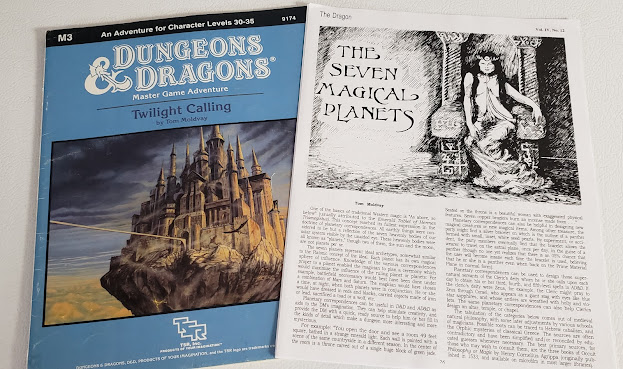
Mystara, The Known World of BECMI
But it was in the Companion and Master Sets that Mystara got its start.
The Known World of B/X was based on the world of Tom Moldvay and Lawrence Schick. He detailed it a bit over at the Black Gate blog. This was expanded on by James Mishler in a post on his blog Adventures in Gaming, The Original Known World. But that only leads us to the B/X known world, not the one in the BECMI Companion and Master sets.

The B/X Known World only occupies the East-most lower gray box. The BECMI World, Mystara, is going to be bigger. Even this is just the continent of Brun.
I am not sure who came up with the idea for Mystara to look the way it does but there are some obvious parallels.
From the Master DM's Book,
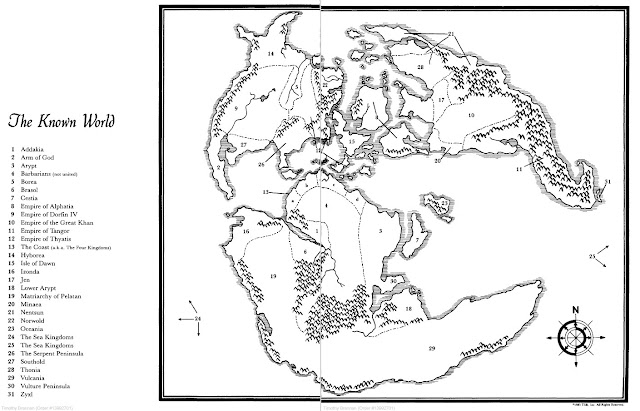
Here is Mystara, courtesy of http://pandius.com/
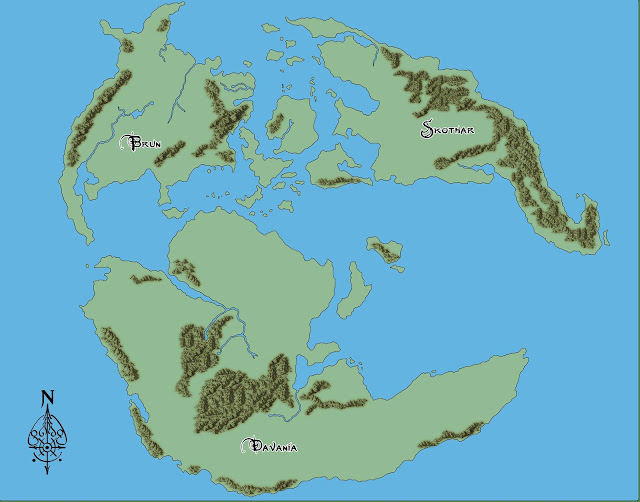
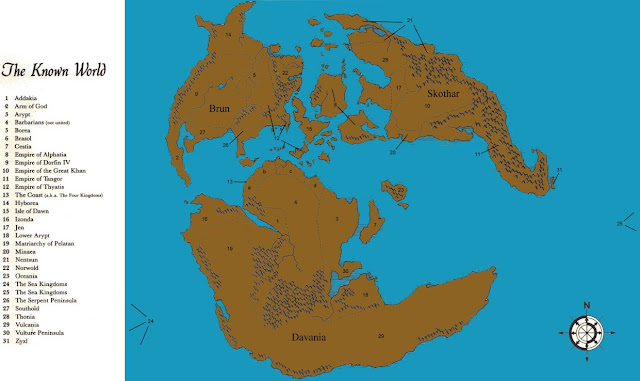
If it looks familiar there is a good reason.
 (image from here, http://www.scotese.com/earth.htm)
(image from here, http://www.scotese.com/earth.htm)That is the Late Jurassic, early Cretaceous period of the Earth, 150+ Million Years Ago.
Long time reader here already know of the Paleomap Map project of Earth History. It has many maps of the different stages of Earth history and potential future maps. I will admit when I first saw maps of the really old Earth it was disquieting to me. I love maps and throughout all of human history, the Earth has been the same. Not so throughout ALL history and prehistory.
It's also kind of cool to see where the places of Mystara will line up to our world.
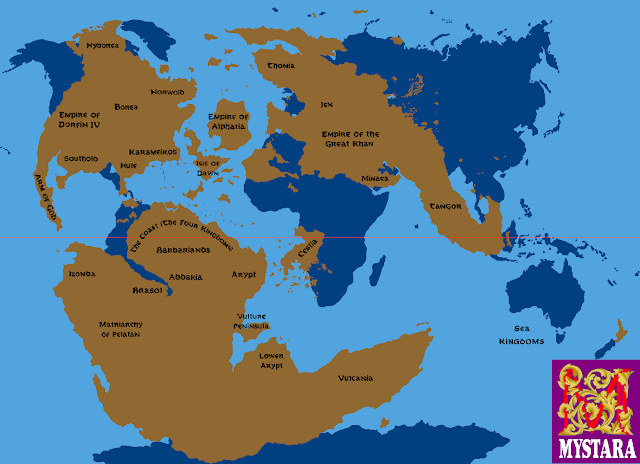 Mystara and the Lands beneath the Waves by GrimklokThe Known World of Mystara was later expanded and given more detail in the wonderful Gazetteer Series, the Hollow Earth series and finally the Challenger series.
Mystara and the Lands beneath the Waves by GrimklokThe Known World of Mystara was later expanded and given more detail in the wonderful Gazetteer Series, the Hollow Earth series and finally the Challenger series.While delving into everything Mystara would take me another month, or another year really, there is still vibrant and active community on the web to support this world. In fact I would say it is far more active than most other worlds. Starting in the early days of the MPGN listserve lists run by TSR, the MYSTARA-L listserve was active back in the days when my access to the Internet was via a mainframe. Many of the same people on those lists then are still active in the various Facebook groups and websites today.
For me, I always had a soft spot in my heart for Mystara. It was the world of my Basic era days and when I moved on AD&D I still kept the world as "my own." It was understood that when I was a player it was in Greyhawk/Oerth but when I was a DM it was in the Known World/Mystara. Eventually, right before college, we merged our worlds into one. I got the western half and my DM got the eastern half. So you know I was thrilled when I found the James Mischler/Chatdemon Mystoerth map. The worlds share a lot of details in common so that a merge was inevitable really.
 Click for largerThis appears to be the original map. While researching this I found an old post by Rich/Chatdemon that offers up an alternate name, Oerstara. I kinda like that. A lot. It sounds like Ostara, the pagan holiday that Easter comes from. Oestara could have been an alternate name for the planet. Like Earth and Terra.
Click for largerThis appears to be the original map. While researching this I found an old post by Rich/Chatdemon that offers up an alternate name, Oerstara. I kinda like that. A lot. It sounds like Ostara, the pagan holiday that Easter comes from. Oestara could have been an alternate name for the planet. Like Earth and Terra.What I love about Mystara (Mystoerth) is that while so much of the world is "known" there are still many, many parts to discover anew. The communities are also very active in detailing new places, moving the timeline forward and adapting material from other sources. I have already seen plans in place to adapt a new 5th Edition book to Mystara months before the book even hits the shelves. That's dedication.
Would I like to see WotC produce new Mystara material? Sure, but if they don't I know the world is in fine hands.
Links
Cottage Cosmos: Alan Jefferson’s ‘Galactic Nightmare’
Richard McKenna / June 23, 2020

Bear with me, because this might get a bit rambling: the way I see it, in a healthy world, not only would we have in hand the levers of the factories, we’d also have the tools for our own artistic fulfillment. And to anyone saying that the tools are there for the buying if you just toil away at the grindstone long enough, I’d reply that tools aren’t simply physical artifacts. Tools are also time, the mental structures like self-belief, the very idea of art as something worthwhile—all of which are etched upon your cerebral cortex by your environment and your upbringing. It isn’t just because we can’t afford brushes that most of us don’t become artists—though for plenty that actually is the reason—it’s because if we do have spare time, we’ve often been trained to feel that art and creativity are not worthwhile ways of using it.
None of this is helped by the establishment’s ongoing drive to turn the clock back to 1902 and formalize creativity into a narrow set of structures accessible only to the wealthy or those the wealthy choose to sponsor. We’re trained to consume their creativity instead of employing our own, so that our “betters” get the structures, spotlight, and funding to follow their muses while our own muses are left moldering in our heads. I don’t mean by this that each of us is necessarily a budding Mozart; I mean that art shouldn’t only be in the hands of those the establishment decides are budding Mozarts—and that Mozarts are in any case an unhealthy metric for judging the value of creativity.
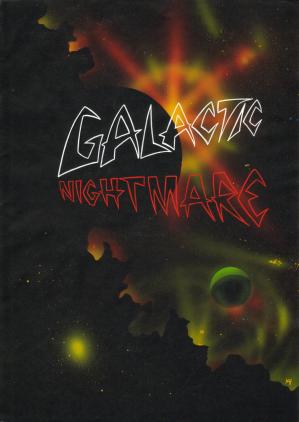
The front page of the Galactic Nightmare story file
Yet, despite all that, fully-formed miniature Mozarts do sometimes appear and seize the tools of creativity for themselves—occasionally at the helms of gleaming spacecraft decked out with banks of pulsing synthesizers. Such is the case of Alan Jefferson, the self-taught polymath behind Galactic Nightmare.
I appreciate that this is a roundabout and slightly bombastic way to start an article about an alien war rock opera concept album made partly in a bedroom in Hull, but Galactic Nightmare deserves flights of rhetoric. Composed, written, played, sung, recorded, and illustrated almost in its entirety by one young Yorkshireman, it tells the tale of how computer expert Doctor Larson discovers a series of extraterrestrial transmissions describing an attack on the inhabitants of planet Zeon by a race known as the Immortals, who plan on using them as cell donors for the serum that gives them their longevity. The Zeons eventually win out, but Galactic Nightmare ends with a newsflash warning that the Immortals are beginning their invasion of Earth.
I don’t know how many of you have been walking around for years with vastly detailed imaginary worlds inside your heads—I know I have—but listening to Galactic Nightmare feels like watching somebody’s head split open, their imaginary world bursting out in full laser-lit, synth-blasting glory: an effect only made more intense by the lovely artwork Alan himself created to illustrate it.
“[I] worked as a milk man on my father’s milk round at Featherstone for a short time before leaving to attend Wakefield Art College when I was 17, where I completed a three year graphic design course,” says Alan. “I left to find there were no jobs for graphic designers without experience and ended up as a corrugated box designer.” After a year of low-paid work in said box design, and a period of low-paid greeting card illustration, he decided to pack it in and go freelance.
Together with a love of art, Alan had long nurtured an interest in recording and making music, becoming involved in it, like many kids, by taping songs from the radio and TV: “I had a reel-to-reel tape recorder when I was 13 and used to tape singles from Top of the Pops with the microphone attached to the TV speaker grill. So I had always been interested in listening and recording music from a young age, but as for playing, that came much later… I was more interested in drawing, making my own SF comic books, and playing football and cricket in the school teams.”

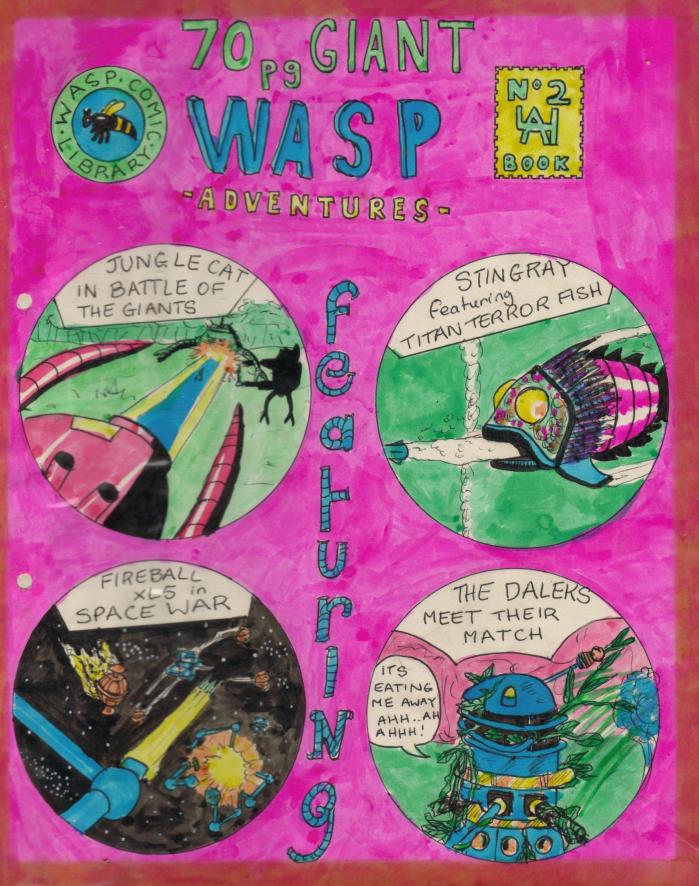

A few examples of Alan’s homemade comics
Alan had been a science-fiction fan since he was a child, drawing his own comics inspired by the strips in the Gerry Anderson TV21 comic and The Eagle, his brightly-colored imagery revealing a vivid personal aesthetic that would later erupt in the artwork for Galactic Nightmare. “The First SF film that inspired me as a child was Voyage to the Bottom of the Sea,” Alan recounts, “[then at] art college, The Omega Man, Planet of the Apes and 2001: A Space Odyssey… and This Island Earth.” With its glowing, unearthly palette and wars on distant planets, it’s perhaps the mood of this last film that Galactic Nightmare most evokes.
Alan’s interest in music led to him working his way up from a tiny squeaking Stylophone to an electronic organ, upon which—inspired by things like Keith Emerson’s crazed antics in The Nice’s performance of “America” on BBC2s Old Grey Whistle Test and Uriah Heep’s performance of “July Morning” on the same program—he undertook to learn to play. “Having no formal music training—as my school had six hours of music in four years and only had kazoos to play—this was extremely ambitious, but I managed it. I then purchased a dual portable organ keyboard and Korg synthesizer and continued to learn songs by ear from records.”
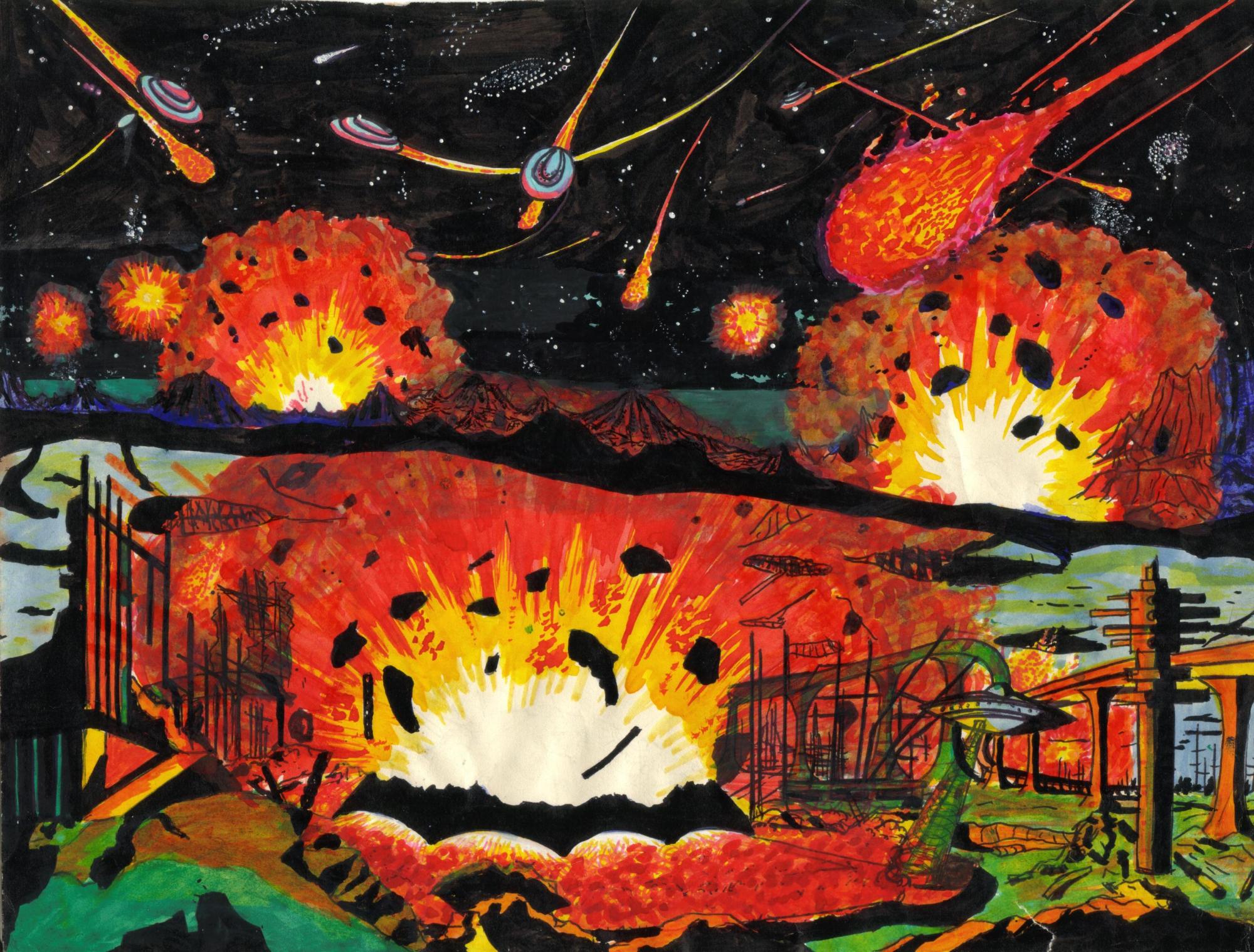
One of Alan’s youthful paintings, inspired by 1955’s This Island Earth
Alan’s art college friend Jack Stoker played guitar and had a deaf next-door neighbor that meant they could rehearse without complaints, so once a week Alan would “… pack my gear into the Mini and make my way to Garforth were we would play the songs I taught him to play. At this time I got the Mini Moog synth due to being impressed by Ken Hensley using one on stage and on records in Uriah Heep.” (And I think we can all appreciate the recursive beauty of a Mini Moog being transported around West Yorkshire inside a Mini.)
After Alan and friend had been playing together for about five years, he purchased a four track TEAC reel-to-reel recorder and mixer to do multi-track recordings, initially recording instrumental covers, laying down each sound separately on the four track and gradually overdubbing, before starting to write original songs that eventually evolved into the demo for an SF concept album influenced by Uriah Heep, Deep Purple, and Boston. Alan sent it around the record companies, but the lukewarm response was that it was not commercial enough.
In 1979, after hearing Jeff Wayne’s 1978 double-LP rock opera adaptation of H.G. Wells’ War of the Worlds, Alan decided to give the SF concept album another try, this time basing it around a narrative. “I had a title for a song called ‘Giant Metal Monsters’ which I wanted to incorporate into the story. So I developed the story around that. In order to be different from H.G. Wells’s ‘War of the Worlds’, I placed my story of alien invasion on another planet with alien beings. I would write the song lyrics first or fit the lyrics to the music. ‘Old and Grey’ is a prime example, where I had this chorus riff and thought of the lyrics to fit it. The whole song then developed from that riff, as did the reason for the Immortal invasion of Zeon in the story.”



Some of Alan’s concept artwork for the Galactic Nightmare packaging
Galactic Nightmare was recorded “in fits and bursts over several years, also while recording other non-SF music” in a 12′ x 12′ room in Alan’s house near Pontefract, and completed in a bedroom in Hull using a Tascam 8 Track reel to reel recorder, Teac 4 Track reel to reel recorder, two cassette recorders, a 6×4 and a 6×2 small mixers, Great British Spring Reverb, Electric Mistress flanger, phaser/distortion/ noise gate pedals, Hammond C3 organ with a Yamaha amp/rotating speaker, a Grant Stratocaster copy, AKG/Sennheiser mics, and Paiste hi-hat and crash symbols.
“The complexity of recording all the sounds individually—in real time, no sequencers then—was extremely time consuming,” says Alan. “Frustratingly, there were also the problems of equipment reliability in those days. For example, the Mini Moog was an expensive synth that needed new keys after six months as they were always wearing out! If I had stuck knives in them as Keith Emerson did in his Hammond organ you could understand it.” In fact, the creation of Galactic Nightmare was at times an actually physically dangerous process. “While I was rewinding the Tascam 8-track recorder, another very expensive machine, one of the large eight and a half inch tape reels flew across the room—very dangerous! It was only held on by two small aluminum nuts.”
The process was grueling in other ways, too. “Mixing down was a nightmare, as you needed four hands on the faders to mix all the sounds from the eight track, four track echo, spring reverb, and cassette deck. We had moved back to Hull again so there was only myself to do it. I ended up mixing down a lot of the tracks in sections down on to the four track and then splicing them together with splicing tape. Many splices had to be redone so you didn’t notice the joins,” says Alan. “Now on computers you can have all these things automated apart from joining tracks. But that is also easier to do on the computer.”
In 1985, six years after he’d begun it, Galactic Nightmare was finished. But the record companies’ cool reception to the demo cassette he sent them—together with a 17-page story file, including lyrics and illustrations—convinced Alan to take matters into his own hands. “Rather than waste my efforts, I made improvements to Galactic Nightmare, including re-recording a different beginning and ending, and decided to release version two myself on vinyl LPs. I designed and illustrated an LP cover using updated illustrations from the story file showing elements of the story, hopefully to get people interested in the musical.”

Releasing it on LP proved prohibitively expensive, so Alan opted for a cassette version that would be accompanied by an A2 poster of the cover art and four-page story file. He placed ads in several magazines, but unfortunately his DIY advertising offensive proved unsuccessful, perhaps victim to the mood of the day—consumer tastes were shifting from small-scale experiment to large-scale bombast, and the country’s various cottage industries were rapidly being marginalized. Alan made a second attempt to spark some interest from UK record companies: “[I] got some nice replies, including one from Sir Tim Rice who found it interesting. Stephen Garrett of Channel 4 urged me to turn it into a stage play. Lucas films and Spielberg films returned everything unread/unheard!”
It took thirty years for Galactic Nightmare to get a proper release. Though its initial appearance hadn’t been the success Alan had hoped, pervasive memories of those strange adverts and the few copies that had circulated gradually accumulated a strange momentum of their own over the decades, and in 2015 Trunk Records released a limited edition Galactic Nightmare double LP. The different format meant editing the the original cassette’s 98 minutes down to 88 minutes to fit four sides, and though not one to shy away from daunting undertakings—as the entire story so far should indicate—Alan admits that “[it] was a nightmare to do, even using computer sequencer software.”
This, then, is the story of Galactic Nightmare—a hand-crafted cosmic odyssey whose vast scope ranges between esoteric locales as disparate as Zeon and Mythmolroyd. It remains a stunning DIY chef d’oeuvre, and Alan’s dedication to realizing his own personal vision over the space of years to little interest from an incurious outside world continues to be inspiring. The quality of the whole thing, from the artwork to the production to the music, completely belies its artisan genesis: in fact, perhaps the only thing that gives Galactic Nightmare‘s origins away might be Alan’s vocals—but, strangely, while I’m sure he’d be the first to admit that he might not have the pipes of a Phil Lynott or a Justin Haywood, the earnest, plaintive quality of his voice only makes the album that much more touching and human, and even more clearly the product of one person’s quest to bring to life his own riotous vision as opposed to some slick, corporate box of delights. It’s galling to think that something so unique was snubbed by record companies who were happy to throw money at forgettable “concept album” dross like the Intergalactic Touring Band.
Them’s the breaks, I suppose. Alan is now retired and considering getting involved with music and painting again—to follow along, visit the Galactic Nightmare website he has put together himself—and has also produced an enhanced version three of Galactic Nightmare that boasts two extra tracks and lasts 110 minutes. Let’s all hope that when it eventually sees the light of day, it gets the treatment and reception it deserves. I don’t know if Alan would agree with my ideas about art and creativity, but what I do know is that we should all take his example and try and make more home-produced concept rock operas about alien invasions—or whatever else—because, like Galactic Nightmare, they can only make the universe a better place.
Many thanks to Alan for very kindly agreeing to speak to us and allowing the use of his artwork, all of which is © Alan Jefferson.![]() Richard McKenna grew up in the visionary utopia of 1970s South Yorkshire and now ekes out a living among the crumbling ruins of Rome, from whence he dreams of being rescued by the Terran Trade Authority.
Richard McKenna grew up in the visionary utopia of 1970s South Yorkshire and now ekes out a living among the crumbling ruins of Rome, from whence he dreams of being rescued by the Terran Trade Authority.
BECMI: Master Set Review
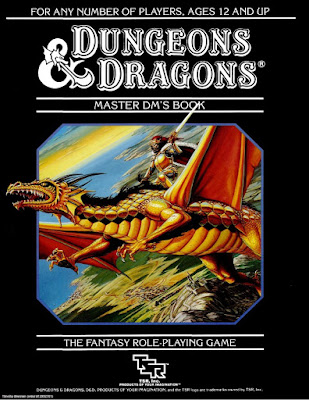 Moving every up we are now at the apex of BECMI D&d Play for normal characters. The journey that began at level 1 in the Basic set is now seeing its end at levels 26 to 36 in the Master Set.
Moving every up we are now at the apex of BECMI D&d Play for normal characters. The journey that began at level 1 in the Basic set is now seeing its end at levels 26 to 36 in the Master Set.This particular set was never on my radar and I only picked one up a couple years ago. The box was beaten up and the contents were water damaged, but still readable. The box also had an extra copy of the Immortal rules inside, so that was a nice bonus. But this has always been something an "other" for me and my D&D game.
Today I look into these rules for the first time in detail.
The Master set covers levels 26-36, following right from the Companion rules. I am going to say that in my reading of both sets I am convinced really that they likely should have been combined into a single set of rules. Big set to be sure, but the overlap is often very significant.
D&D Master Set (1985)
As with the previous BECMI Sets, I am reviewing both my boxed set and the PDFs available from DriveThruRPG.
The Master Players' Book
This book is the smaller of the two at 32 pages. Color covers, black & white interiors.
There are some interesting things to note on page 1. First, we are told this is the Dungeons & Dragons game by Gary Gygax. Dave Arneson is no longer listed. Also, this book is "compiled by" Frank Mentzer as opposed to "written by." I am not going to try to read too much into this. Writing on the book was complete in Spring 1985. It would be published that summer in July but it would soon be eclipsed in sales by the Unearthed Arcana for AD&D which had sold well. Though in 3-4 months it would all change and Gygax would be ousted from TSR. But that is a topic for another day.
Like the previous books, this one covers all the details needed for characters up to the vaulted 36th level. Clerics and Magic-users see the most text devoted to them. Clerics gain additional turning abilities which include more monsters and the ability to affect more monsters. They also get more spells but still top out at 7th level. More druid spells are also presented here. Magic-users also get more spells including the most abused spell in D&D history, Wish. Again they top out at 9th level spells. Even clerics get access to Wish if they are 36th level and have a wisdom of 18 or greater. Magic-users also get Heal. Which I admit seems a little odd to me.
Fighters get half of a column or 1/6 of a page for their updates. Thieves get a page. Dwarves, Elves, and Halfling get a page to share.
There are some new armor options, but the biggest inclusion is that of Weapon Mastery. This mimics the Weapon Proficiency we will see in the Unearthed Arcana and future editions of D&D. Essentially fighters are better with a chosen weapon. while I have heard and read that this can lead to fighters becoming too powerful at early levels, I don't think this is really a big deal. I like the idea that a fighter should be able to train with a weapon exclusively and become better at it.
We get expanded weapon and damage charts to include all the weapons that have been added since the Basic set. Plus some Pole-arms (maybe Frank was looking over Gary's shoulder a few times!)
There is even a section on siege weapons that can be used with the War Machine rules.
so a lot yes, but nothing that really screams Masters to me. A lot of what is here could have been added to the Companion rules for a 48 page Player's book.
The Master DM's Book
This is the larger at 64 pages. Color covers, black & white interiors.
One of the neatest bit of this book is finally getting a map of the Known World. It is so great that I am going to devote an entire post just to that later this week.

Like the books before it, this section is given over to Procedures first. First up is a ruling on Ant-Magic Effects. Good to have really for any version of the game. some detail on characters are also given including Character Background. It is 1985 after all. A couple of other things stand out. We get our first taste of the Immortal rules here with the introduction of the idea of Immortals as the "next level up."
Monsters get an upgrade here with expanded to hit tables; Creatures to 33+ HD and Armor Classes from 19 (yes +19) to -20. But that is not all. Monsters also get an average Intelligence rating. All creatures from all four sets are covered. Along with this intelligence rating, there is an optional change to charm based on intelligence. It's neat, but I would rule that intelligence has no effect at all on charm magic. No that is the realm of Wisdom. In my copy I would cross out "Intelligence" and replace it with "Wisdom."
Included here for some reason is also the Mystic class. Expect it is not really presented as a full class. It is not the Mystic that Gygax was talking about in Dragon magazine, but rather a different version of the AD&D monk. It appears again in the Monster section.
Another update to monsters, in particular, non-human monsters are spell casting monsters. Dragons are discussed, but we also get the Shaman NPC class (Clerics) and the Wicca NPC class (Magic-Users). There are some interesting ideas here and some level limits for a large variety of monsters. I am curious as to why Frank choose "Wicca." I am sure that the meaning here is "witch" and that is not just my biases. If you look back over the various BECMI books Wicca, Witch, and Wokani get used failry interchangeably. I discussed this in a recent Class Struggles post.
On the other end of the spectrum from Immortals, we also get Undead Liege Lords and how they can control lesser undead. Also useful for any version of the game.
The next big section of the book belongs to the Monsters. Like the Companion Set this one is broken up into Prime Plane creatures and outer plane creatures.
Here we get some very new looking monsters that would only later move on to the main AD&D/D&D lines. We also get what I like to call BECMI versions of some others. The Devilfish is essentially an Ixitxachitl. Blackballs remind me of Xeg-yi. We do get new Dragons in name, Crystal, Onyx, Jade, Ruby, Sapphire and Brown. But they share stats with dragons we already know. We also get the four rulers of the Dragon kind, Pearl, Opal, Diamond and the Great Dragon. There are Drakes which are not exactly like the Drakes of later D&D and closer to shapeshifters. These could even pass for the elusive Mystaran Dragonborn.
We also get Faeries, Hags and Liches to round out what I consider some of the classical monsters.
Part 3 of the monsters listing includes stats from all sorts of B/X and BECMI monsters published elsewhere (other rules, modules) and then brought into the fold of the full BECMI rules. So even the oddities like Brain Collectors and Lupins from X2 Castle Amber are here.
The last 20 pages of the rules cover magical artifacts; something we have not seen in BECMI to any degree yet. There are detailed rules for artifact creation and a number of new artifacts. Many I have never seen before and none copied over from the AD&D DMG.
In fact, there is so much here that I am going to cover it all in a future post.
There are only a few "normal" magic items listed at the end.
Ok. So the Masters Rules feel very uneven to me after the Companion Rules. I could see where it might have been better to instead take both sets and merge them into one and maybe top out at 25th or 30th level really. We will see that re-organization in the future.
Fighters went from getting all the new fun details to nearly nothing in going from Companion to Masters. Clerics and Magic-users get more spells, but that is about it. Thieves suffer the most for now having to have their abilities amortized over 36 levels.
There are some great new monsters in the Master's rules, very few save for the various "rulers" even have Master's level HD (26+).
The artifacts though are great and really gives a feel for what a Master's Level game could be about.
The art feels lighter in this set than the previous ones. The only Elmore art is the cover.
Monstrous Monday: Sasquatch (BECMI Special)
Saturday was the first day of Summer for 2020 and Summer and June usually meant one thing in my house back in 1983. The local Public Library's Summer Reading program!
When I was younger I devoured books on monsters, aliens and all sorts of strange creatures.
I have detailed my interactions with some of these books that I was able to find more recent as an adult elsewhere here on my blog.
But today is special. Today is the confluence of a number of topics in a perfect way. Today I will post my review of the BECMI Master's set. It is summer. It is a Monster Monday. What better monster for today than the one that is really at the root of my monster love.
Bigfoot, or the Sasquatch.
Around the same time I was getting into D&D we also subscribed to Showtime, one of the first cable channels out. The film Sasquatch, the Legend of Bigfoot was on heavy rotation on the channel then (that and Smokey and the Bandit). It was a pseudo-documentary, but it really set the stage for some of the games I would later play; the monster naturalist.
Here is a sasquatch I developed originally in 1986-87. I used these stats later to develop the Almasti for Ghosts of Albion later on.
 Sasquatch
SasquatchArmor Class: 6
Hit Dice: 6*
Move: 180' (60')
Attacks: 2 fists or rock throw
Damage: 6-11 (1d6+5) / 6-11 (1d6+5) or 7-21 (2d8+5)
No. Appearing: 0 (1-10)
Save As: Fighter: 5
Morale: 7
Treasure Type: Nil
Alignment: Neutral
XP Value: 500
The sasquatch, also known as the "Bigfoot", is a large humanoid creature. It is neither human, orc or even an ogre. The creature is elusive and extremely shy. Very little is known about the creatures and most urban scholars doubt they even exist.
What is known is this. The sasquatch ranges from 7' to 9' tall, and weighing between 650lbs to 1,000lbs. They have long torsos, long arms with massive hands, shorter legs but large feet which gives them their name. They are strong, 22 Strength, have dark brown, reddish or black fur like that of an ape. What is often most remarked about them is their strong odor which gives them their other common name, the "skunk ape."
The sasquatch can blend into surroundings making them difficult to spot. They can only be seen on a roll of "1" on a d20. Their odor makes it difficult for them to completely surprise. They can only surprise on a roll of 5 or 6 on a d6.
They are normally non-aggressive, preferring to hide, and stay away from all others save their own family units. If pressed they will attack, or if they feel their family unit is in danger.
The sasquatch can attack with two fists or throw boulders, much like a giant. The sasquatch can also howl. This howl causes fear (as per the spell) to all that hear it who fail a saving throw vs. Paralysis. Those that fail the save are too frightened to attack or move.
--
I mentioned here before that my "first monster manual" was by Daniel Cohen and not Gary Gygax.
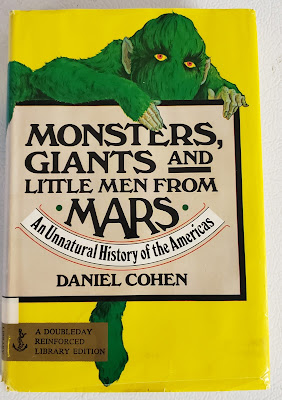
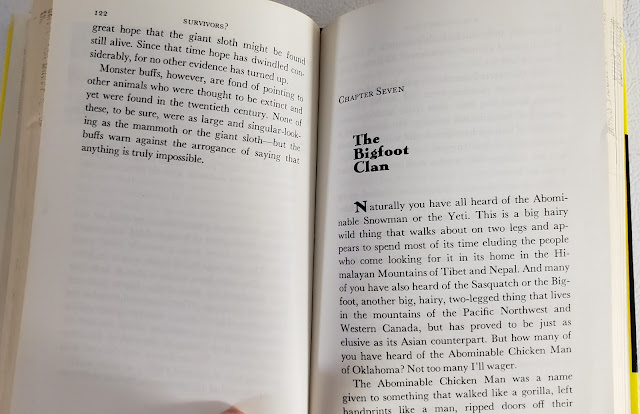
This plus my Moldvay set keep me going for a very long time.
Jonstown Jottings #21: Blue Moon, White Moon
—oOo—
 What is it?
What is it?Blue Moon, White Moon is a short one-night (one session) scenario for RuneQuest: Roleplaying in Glorantha.
It is a fifteen page, full colour, 9.71 MB PDF.
Blue Moon, White Moon is well presented and organised. Its NPC illustrations are excellent, but the scenario needs a slight edit.
Where is it set?
Dragon Pass, specifically Sartar, but it could be set anywhere where the rule or influence of the Lunar Empire has been felt.
Who do you play?
Adventurers with a few adventures under their belt with a prejudice against the Lunar Empire. The scenario may have more of an emotional impact if one of the player characters is a Lunar Tarshite. It may also be quite fun if a player character is an Issaries initiate.
What do you need?
RuneQuest: Roleplaying in Glorantha. It can also be run using the RuneQuest: Roleplaying in Glorantha – QuickStart Rules and Adventure. Access to A Rough Guide to Glamour may provide further background and context, but is not needed to play Blue Moon, White Moon.
What do you get?
Blue Moon, White Moon is a short, simple scenario which presents the player characters with a physical and a moral challenge. In it, they encounter an Imperial assassin from the Lunar Empire. Fortunately, she is not after them, but is in fact on the run. The question is why, and then, what do the player characters do about or with her? By default, player characters in RuneQuest: Roleplaying in Glorantha are from Dragon Pass and are likely to possess strong feelings towards the Lunar Empire. Blue Moon, White Moon is intended to test those prejudices and perhaps give them a slightly altered view of the Lunar Empire.
The other aspect to the scenario’s set-up is that the assassin has encountered some bandits. This is where the player characters enter the story—are they hunting the bandits, is the assassin hunting the bandits, is this a chance encounter, and so on? All of this will probably be resolved in the scenario’s first scene, the second scene will revolve around what the player characters decide to do about the assassin and the consequences of this decision. Although the scenario will involve some combat, this decision lies at the heart of Blue Moon, White Moon. Ideally, it should foster no little roleplaying at the table and despite the brevity of the scenario’s length, those consequences could continue to play out in a campaign for a while after.
The scenario is easy to set up, has only three NPCs which the Game Master will need to handle, and requires relatively little preparation. The simple set-up also means that the scenario could any time that the player characters are on the road or between other scenarios, and its short preparation time means that it could also be dropped into a campaign at as equally short a notice. Ultimately consisting of just two scenes, Blue Moon, White Moon is really all about the set-up, leaving the Game Master and her players to explore the consequences, the Game Master needing to adjust and adapt as normal.
Besides the three NPCs—only one of whom is actually a ‘villain’ (and as written, it is not who the player characters will think it is given their probable Passions)—the Game Master is given details of a new Occupation, the Blue Moon Assassin, one of the Lunar Emperor’s septet of personal protectors and executioners and two associated new Rune spells. These are likely for the use of these NPCs only, that is unless a player really, really wants to play an extremely challenging character.
Lastly, Blue Moon, White Moon would also work as a convention scenario. Especially for players with some experience of Glorantha.
One minor issue with Blue Moon, White Moon is that it shares a similar ‘Lunar woman in peril’ set-up as Jorthan’s Rescue Redux,* which was also designed to test the player characters’ prejudices towards the Lunar Empire. Of course, the actual set-up and scenario is otherwise entirely different, and the testing of the player characters’ prejudices is implicit rather than explicit. Nevertheless, the Game Master should be wary of running the two scenarios too closely together.
* Which in the interests of disclosure I did write.
Is it worth your time?
Yes. Blue Moon, White Moon is an excellent scenario which will present the player characters with an interesting moral dilemma and test their passions. It is also quick to set up and add to a campaign. It is also written by John Wick.
No. Blue Moon, White Moon will be of little use to you if your campaign is not set anywhere near Sartar or you want nothing to do with the Lunar Empire.
Maybe. The Lunar Empire and its minions get everywhere, and one day your player characters might run into the ‘worst’ of them.
Readjusting Race
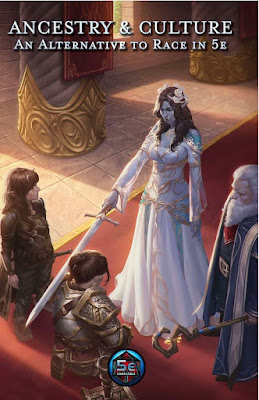 Dungeons & Dragons has a problem. From Dungeons & Dragons to Basic Dungeons & Dragons and Advanced Dungeon & Dragons, First Edition to Dungeons & Dragons, Fifth Edition, that problem has been one of Race. In Dungeons & Dragons, a player’s choice of Race has always what core special abilities his character has, what attribute bonuses, what training he has undertaken, through a common Alignment for that Race, what his outlook upon the world is, as well as in many cases, what the world’s outlook is of his Race is in general. So under the current version of the rules, a Dwarf will an increased Constitution of +2, a starting age of fifty, tend to be of Lawful Alignment, stand between four and five feet tall and weigh about one-hundred-and-fifty pounds, be of Medium Size and have a base walking speed of twenty-five feet, have Darkvision, Dwarven Resilience against poisons, Dwarven Combat Training with battleaxes, handaxes, light hammers, and warhammers, tool proficiency with either smith’s tools, brewer’s supplies, or mason’s tools, and Stonecunning, a proficiency bonus in things related to stone. This question is, is this a typical Dwarf? Are all Dwarves like this? If so, is this not a racial stereotype, and would a Dwarven scribe have proficiencies with different tools rather than either smith’s tools, brewer’s supplies, or mason’s tools? Might the Dwarf be trained in different skills depending upon where and among whom he grew up? What if he grew up in a Halfling village, would he be exactly the same as the rules say he should be?
Dungeons & Dragons has a problem. From Dungeons & Dragons to Basic Dungeons & Dragons and Advanced Dungeon & Dragons, First Edition to Dungeons & Dragons, Fifth Edition, that problem has been one of Race. In Dungeons & Dragons, a player’s choice of Race has always what core special abilities his character has, what attribute bonuses, what training he has undertaken, through a common Alignment for that Race, what his outlook upon the world is, as well as in many cases, what the world’s outlook is of his Race is in general. So under the current version of the rules, a Dwarf will an increased Constitution of +2, a starting age of fifty, tend to be of Lawful Alignment, stand between four and five feet tall and weigh about one-hundred-and-fifty pounds, be of Medium Size and have a base walking speed of twenty-five feet, have Darkvision, Dwarven Resilience against poisons, Dwarven Combat Training with battleaxes, handaxes, light hammers, and warhammers, tool proficiency with either smith’s tools, brewer’s supplies, or mason’s tools, and Stonecunning, a proficiency bonus in things related to stone. This question is, is this a typical Dwarf? Are all Dwarves like this? If so, is this not a racial stereotype, and would a Dwarven scribe have proficiencies with different tools rather than either smith’s tools, brewer’s supplies, or mason’s tools? Might the Dwarf be trained in different skills depending upon where and among whom he grew up? What if he grew up in a Halfling village, would he be exactly the same as the rules say he should be?Another problem with Dungeons & Dragons and race is why are there only Half-Orcs and Half-Elves? And why only with Humans? And why such characters with mixed parentage always seem to have difficulty with the Race of one of their parents—of not both? Then another problem with Dungeons & Dragons and race is a continuation of the Race as stereotype issue. That problem can be addressed by answering the question, “What is the point of Orcs?”. Author N.K. Jemisin’s answer is that, “Orcs are fruit of the poison vine that is human fear of “the Other”. In games like Dungeons & Dragons, orcs are a “fun” way to bring faceless savage dark hordes into a fantasy setting and then gleefully go genocidal on them.” By extension, this answer can be applied to the Drow too, but essentially the answer is that depicting Orcs, Half-Orcs, and Drow as evil and vile—and in the case of the first two, rapists and the victims of rape—is, well, racism.
Now if you disagree with those points or you do not think that such questions should be answered, or even asked, then this review is not for you. Nobody is going to come to your house and tell you that the way you play Dungeons & Dragons is wrong. It might not be how the designers intended Dungeons & Dragons to be played and it might not be what some parts of the Dungeons & Dragons community want to hear about the game being played. If so, then again, this review is not for you, and the book being reviewed, Ancestry & Culture: An Alternative to Race in 5e, is not for you. Similarly, that does not mean that there are no reviews on Reviews from R’lyeh of interest to you. For example, here is a review of G2 Glacial Rift of the Frost Giant Jarl which was only published last week. However, if you are interested—whether with a sceptical or an open mind—in hearing about solutions to the problems that Dungeons & Dragons has with race and racism, then this review is for you. And if you think that Wizards of the Coast, the publisher of Dungeons & Dragons, Fifth Edition, is right to address the issue, then this review is also for you.
Ancestry & Culture: An Alternative to Race in 5e is published by Arcanist Press. It is a supplement for Dungeons & Dragons, Fifth Edition which offers solutions to both counter the problem of racism in the roleplaying game, options to enhance the diversity in the game, and a pair of scenarios which feature this diversity and have an emphasis on co-operation and roleplaying rather than on direct combat. The supplement begins by examining the problem, looking at where it originates from, and identifying how it exhibits in Dungeons & Dragons, Fifth Edition. At its heart, the roleplaying game takes a number of elements, mixes them together, and packages together under the term, Race. Fundamentally, it packages elements which are genetic—Age, Size, Speed, Darkvision, and so on, together with those which due to upbringing—Ability increase values, Alignment, Tool Proficiencies, and the like. The solution that Ancestry & Culture: An Alternative to Race in 5e offers is to take each ‘Race’ as defined in Dungeons & Dragons, Fifth Edition and divide its constituent parts into packages—or Traits—of their own. These Ancestral and Cultural Traits. So into the Ancestral Trait goes all of a species’ traits which would be inherited from their parents, that is, the simply biological elements such as Age, Size, Speed, Darkvision, and so on. This leaves learned or trained traits like Alignment, Languages, Proficiencies, Attribute bonuses, and so on, to go into the Cultural Trait. Thus, the Dwarven Ancestral Traits consist of Age, Size, Speed, Darkvision, Dwarven Resilience, and Dwarven Toughness, whereas the Dwarven Cultural Traits are made up of the Ability Score Increases—Constitution by two and Wisdom by one, Alignment, Dwarven Combat Training with battleaxes, handaxes, light hammers, and warhammers, tool proficiency with either smith’s tools, brewer’s supplies, or mason’s tools, and Stonecunning, a proficiency bonus in things related to stone, and the Dwarven language.
Now one of the issues with repackaging is where the Attribute bonuses go and it does look odd for them to be under the Cultural Trait and so suggest that they due to upbringing rather than innate, biological nature. After all, this is how it has been for the past forty years. The explanation is simple. The designers have moved away from the problematic concept that intelligence or strength is higher or lower in certain ethnic groups, a concept which underpins various aspects of racism. That said, as a player or a Dungeon Master there is nothing to stop you playing a Dwarf who was brought up among the Dwarven culture and combining the Dwarven Ancestral Trait and the Dwarven Cultural Trait to create a Dwarf in Dungeons & Dragons, Fifth Edition. The division though, allows a couple of interesting options. Most obviously you could create a character with Diverse Cultural Traits, that is, a character of one species who was brought up in the culture of another, so a character with the Ancestral Trait of one species and the Cultural Trait of another. For example, a Halfling who was brought up amongst Dwarves or a Human who was bought up amongst the Elves—such as Aragon did in Tolkien’s The Lord of the Rings. The other is Mixed Ancestral Traits in which a character has one parent of one Ancestral Trait and one parent of another Ancestral Trait. So you could have a Tielfling-Elf or a Halfling-Dwarf or a Dragonborn-Human and Ancestry & Culture: An Alternative to Race in 5e provides rules on how to do this.
In addition, Ancestry & Culture: An Alternative to Race in 5e offers two appendices offering additional rules, options, and resources. These include further rejecting the essentialist nature of the Cultural Traits which still suggests that a member of any one culture will have the same traits, so someone who grew up amidst a Dwarven culture would always have high Constitution and Wisdom, a Lawful Alignment, Dwarven Combat Training, particular Tool Proficiencies, and Stonecunning. How then, would you do a Dwarven scribe or merchant or entertainer. Here Ancestry & Culture: An Alternative to Race in 5e provides the means to create that by giving a player the choice in what Attributes to increase, Tool Proficiencies to select, and the like. The supplement actually gives the Ancestral Traits and Cultural Traits for the core species in the Player’s Handbook—Dragonborn, Dwarf, Elf, Gnome, Halfling, Human, Orc, and Tielfling, so that a gaming group can just slot that in the character creation process with ease. Of any other species, a second appendix suggests how they can be adapted to the new format of the Ancestral Traits and Cultural Traits.
Ancestry & Culture: An Alternative to Race in 5e also includes two scenarios. Both are what the author calls ‘’An Ancestry and Culture Adventure’ and both are set in and around communities with diverse, mixed-heritage populations. Both are designed for a party of five Third Level characters, but advice is given to adjust as necessary for weaker or stronger parties. In ‘Light of Unity’, the player characters come across a village beset by a shadowy corruption emanating from a nearby forest where a team of archaeologists has recently gone. To get the best out of the scenario, the player characters need to interact with the villagers and learn more of what is going on before proceeding to the source of the mystery. The interactive and roleplaying elements of the scenario are its best feature because otherwise ‘Light of Unity’ still adheres to the well-worn ‘village in peril’ set-up. It does not mean that it is unplayable, but perhaps just familiar. The second scenario, however, ‘Helping Hands’ takes the set-up one step further. It has a village in peril, in fact ablaze, but not only has the player characters help with the fire and the ensuing panic, but has them deal with the consequences, going for help in neighbouring communities. What is so enjoyable about ‘Helping Hands’ is that the solutions to problems it poses to the player characters are do not rely upon combat, but investigation and interaction. This is not to say that there is no combat in the scenario, but the emphasis is not upon fighting.
Physically, Ancestry & Culture: An Alternative to Race in 5e is well written and presented. The maps are clear, but the standout feature is the artwork—which is gorgeous. None of it is in colour, but the depictions of a Dwarf of Dwarf Ancestry and Elf Culture, of a character of Dwarven and Orcish Ancestry and Orcish Culture, and others are really quite lovely.
If Ancestry & Culture: An Alternative to Race in 5e is missing anything, it is perhaps that it does not explore what mixed cultures look like. It does what a character of mixed culture and heritage will look like, easily slotting into the Dungeons & Dragons, Fifth Edition character creation process to do so, but not what a society and a culture might look. Of course, the scope for that would be enormous, but some advice might have been useful.
Ultimately, if you have an issue with either the questions raised by Ancestry & Culture: An Alternative to Race in 5e or the solutions its offers, then the book is entirely optional. Bear in mind though, that Wizards of the Coast will be addressing them as the publisher of Dungeons & Dragons, Fifth Edition and so the roleplaying game will be changing. And again, nothing is stopping you from ignoring those changes and adhering to the version that you like. However, what Ancestry & Culture: An Alternative to Race in 5e is doing—and what Wizards of the Coast is going to do—is looking at Dungeons & Dragons from another perspective and asking difficult, uncomfortable questions about the game, and not only identifying problems with the game, but offering solutions. And even if you still want to play a Halfling who is a Halfling with both the Halfling Ancestral Trait and Cultural Trait or a Tielfling with both the Tielfling Ancestral Trait and Cultural Trait, you still can, but other players sat round the table might not want to, and Ancestry & Culture: An Alternative to Race in 5e gives them options to mix and match the options that they want, to create the characters that they want. Plus, it is doing it without the stereotyping of the Race element in Dungeons & Dragons. It means that you can create characters who can still be interesting without being stereotypes or clichés and without being, well, racist—even if unintentionally.
GAZ 3 The Principalities of Glantri Print on Demand
The Principalities of Glantri, Print on Demand version.
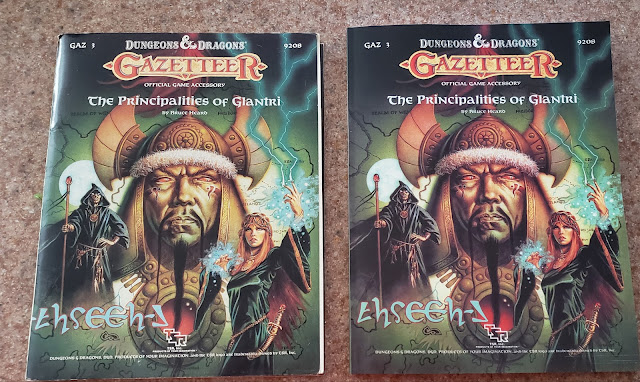
I reviewed the PDF and my original print version some time ago, so if you want to check that out it is here.
The PoD is fantastic really, and great to have since this is the one Gazetteer that sees the most use out of all my Basic-era books.
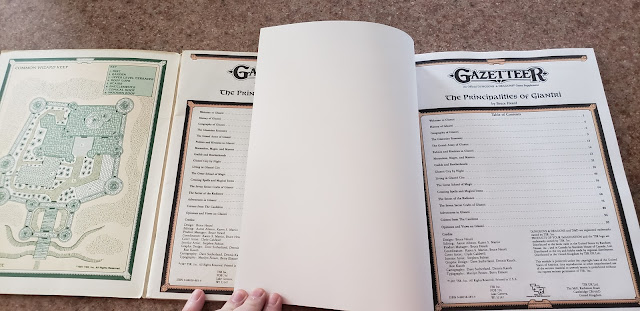
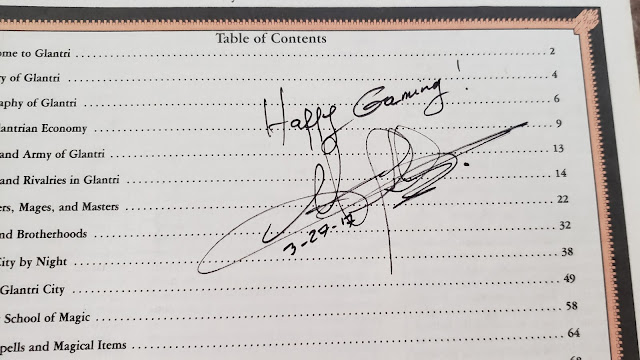 My original signed by Bruce Heard.
My original signed by Bruce Heard.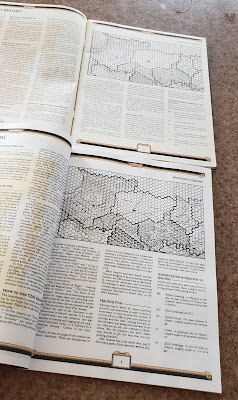
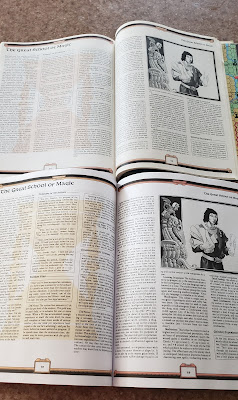
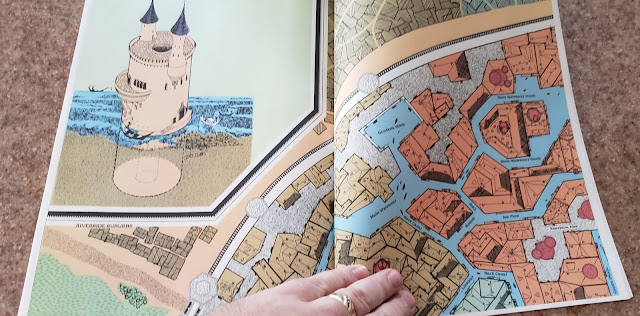
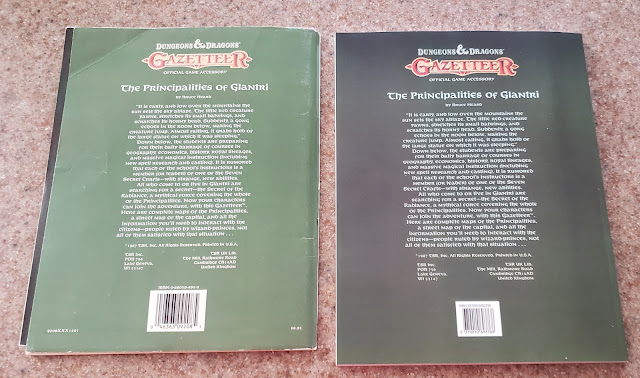

The original Gaz 3 cost $8.95 back in 1987. This one set me back $7.66.

Yeah, no shipping since it is part of a multi-shipment. Part two should be here next week. I hope so, I have a lot to say about that one.
The maps are attached to the spine, so not as useful as they could be, but getting the PDF is part of the PoD, so I can always print them out if I don't want to use my originals.
For the price being able to put up my original and have one I can use daily if needed is a steal really.
Each PoD has been getting better and better. This one seems to be best so far.
A Cthulhu Collectanea II
 As its title suggests Bayt al Azif – A magazine for Cthulhu Mythos roleplaying games is a magazine dedicated to roleplaying games of Lovecraftian investigative horror. Published by Bayt al Azif it includes content for both Call of Cthulhu, Seventh Edition from Chaosium, Inc. and Trail of Cthulhu from Pelgrane Press, which means that its content can also be used with Delta Green: The Role-Playing Game and The Fall of DELTA GREEN. Published in September, 2019, Bayt al Azif Issue 02 does not include any content for use with the latter two roleplaying games, but instead includes three scenarios—stated for both Call of Cthulhu, Seventh Edition and Trail of Cthulhu, discussion of how to run a specific modern campaign, a review of a recently-rereleased classic campaign for Call of Cthulhu, interviews, an overview of Lovecraftian investigative horror roleplaying in 2018, and more. All of which, once again, comes packaged in a solid, full colour, Print On Demand book.
As its title suggests Bayt al Azif – A magazine for Cthulhu Mythos roleplaying games is a magazine dedicated to roleplaying games of Lovecraftian investigative horror. Published by Bayt al Azif it includes content for both Call of Cthulhu, Seventh Edition from Chaosium, Inc. and Trail of Cthulhu from Pelgrane Press, which means that its content can also be used with Delta Green: The Role-Playing Game and The Fall of DELTA GREEN. Published in September, 2019, Bayt al Azif Issue 02 does not include any content for use with the latter two roleplaying games, but instead includes three scenarios—stated for both Call of Cthulhu, Seventh Edition and Trail of Cthulhu, discussion of how to run a specific modern campaign, a review of a recently-rereleased classic campaign for Call of Cthulhu, interviews, an overview of Lovecraftian investigative horror roleplaying in 2018, and more. All of which, once again, comes packaged in a solid, full colour, Print On Demand book.Bayt al Azif Issue 02 opens with editorial, ‘Houses of the Unholy’, which really takes stock of the progress of the magazine from the first issue to this one. So it is somewhat reflective in nature before it sets out what the Bayt al Azif Issue 02 is all about, and so is also focused on the job at hand. Its reflective nature is coupled with ‘Sacrifices’ and then ‘Cthulhu in 2018: A Review’. ‘Sacrifices’ is the letters page, which covers the response to Bayt al Azif Issue 01 and so lays the background for the potential community which come to be built around the magazine. ‘Cthulhu in 2018: A Review’ is by Dean Englehardt of CthulhuReborn.com—publisher of Convicts & Cthulhu: Call of Cthulhu Roleplaying in the Penal Colonies of 18th Century Australia. In Bayt al Azif Issue 01, he presented ‘CthuReview 2017’, a look back from 2018 of the previous year in terms of Lovecraftian investigative horror and its associated segment of the gaming hobby. It covered the notable figures and their doings as well as the various publishers, projects, Kickstarters, and more. Now ‘Cthulhu in 2018: A Review’ does not look at the notable figures in the hobby, so focuses on the releases, the Kickstarters—fulfilled and unfulfilled, the highlights, and the trends. From Masks of Nyarlathotep to the Yellow King Roleplaying Game, Devil’s Swamp to Crawl-thulhu, Sandy Petersen's Cthulhu Mythos to The Shadow Over Dunsmore Point, this is an extensive overview, which again nicely chronicles the year keeps us abreast of anything that we may have missed or forgotten. (An interesting touch is that the author does include links to reviews of some of these titles—including some to Reviews from R’lyeh. Of course these look a little odd in print, but highlight the origins of the article as an online piece.)
Bayt al Azif Issue 02 has a decidedly Germanic feel to it. This is because it follows in the footsteps of Worlds of Cthulhu which adapted over the course of its six issues, content from the official German Cthulhu magazine, Cthuloide Welten. Bayt al Azif plans to draw content from another German Cthulhu magazine, Cthulhus Rus, and to that end, Bayt al Azif Issue 02 includes a number of German-sourced pieces. The first of these is Ralf Sandfuchs’ ‘Who Needs Lovecraft Country? – Why the Weimar Republic is the Best Setting for Cthulhu Games’, which espouses the virtues of interwar Germany as a setting for roleplaying games of Lovecraftian investigative horror. We have already seen this potential come to the page with the publication of Berlin: The Wicked City – Unveiling the Mythos in Weimar Berlin, but this only focuses on Germany’s capital, so there is yet a supplement dedicated to Germany as a whole to be published. Certainly, this article makes the case that Germany is highly suitable and certainly, Berlin: The Wicked City is good starting point for any Keeper interested in the setting.
The content sourced from Cthulhus Rus continues with ‘False Friends’, a scenario by Philipp Christophel and Ralf Sandfuchs. Set in the 1920s and the university town of Göttingen, ‘False Friends’ is designed as an introductory scenario and is the first part of a campaign, further installments of which will appear in future issues of Bayt al Azif. A young student, recently gone up to university, missing under odd circumstances, and her worried parents ready to engage the investigators to find their daughter, will be familiar to any veteran of Lovecraftian investigative horror roleplaying games. So on the whole, this is a comparatively simple, straightforward scenario, and whilst the background of Germany after the Great War adds a degree of social conservatism, perhaps an opportunity was missed to frame the differences between roleplaying in the USA or United Kingdom of the period and in the Weimar Republic. Like all three scenarios in Bayt al Azif Issue 02, ‘False Friends’ includes stats for both Call of Cthulhu, Seventh Edition and the GUMSHOE System of Trail of Cthulhu.
The second scenario is Ash DelVillan’s ‘Nighted’. This is a Cthulhu by Gaslight scenario set in England in 1899, in which the player characters are invited to a masquerade at a country mansion. It is written primarily as a one-shot with pre-generated characters with links to each other and the NPCs. Like ‘False Friends’, the format is very familiar—a country house, a masked ball, a wayward host, and rooms packed with curio after curio. Then of course, it turns into a locked room situation, one with threats from without, and growing within! This drives the second half of the scenario, the first being the invitation and the manners of the player characters to stay in the mansion and await their host. It is fairly tightly plotted in terms of its timing and ratcheting up of the tension. It does deliver a nasty poke in the eye—or two—and will probably have the player characters scrambling to find a solution to their situation as lycanthropic creatures stalk the grounds outside.
There is lycanthropic theme—more obviously so, in the third scenario, ‘Beasts of Gévaudan’. As the name suggests, Bridgette Jeffries’ scenario is set in 1760s and is inspired by real events. The investigators are tasked by the crown—and some by other interested parties—to travel to the region and determine the cause of the attacks. Again, this is a one-shot, its pre-generated investigators each having their motives which should add to the tension as the relatively simple investigation is carried out. The scenario should involve a high degree of action and horror, but ultimately will present the players and their investigators with a moral choice. ‘Beasts of Gévaudan’ has enjoyable historical feel to it and should derail anyone coming to it thinking that it will be like the film, The Brotherhood of the Wolf.
A whole campaign comes under scrutiny in Lisa Padol’s ‘Adapting a Scenario – Our Ladies of Sorrow’. The editor examines the non-Call of Cthulhu modern horror campaign published by the much missed Miskatonic River Press in 2009 in some detail, highlighting some of the difficulties faced in both adapting it to Trail of Cthulhu and to the early nineteen-sixties. It is a highly detailed, often character-focused piece that is worth the time of any Keeper wanting to run the campaign. Or indeed get some idea how to individualise any campaign, although it is very specific to Our Ladies of Sorrow. The issue with the article is that the campaign has been out of print for a decade and unless it is reprinted or a copy can be found on the second-hand market, its contents are not immediate use.
There are just two reviews in Bayt al Azif Issue 02—and they are a huge improvement upon the two reviews in Bayt al Azif Issue 01. First, Stu Horvath discusses Masks of Nyarlathotep in ‘Vintage RPG’. If his reviews in the first issue were slight and image heavy, here the author is given the space cover the history of, as much review, the new edition and it shows in being a better written, more detailed, and interesting article. For veterans of Call of Cthulhu, there will be much here that is familiar, but for anyone new to Call of Cthulhu will nevertheless, this is informative and interesting. The second review is actually of Call of Cthulhu itself, but not of Call of Cthulhu, Seventh Edition. Rather, ‘“It is not dead which can eternal lie…” Game Review: Call of Cthulhu’ is actually a review of Call of Cthulhu, First Edition by J. Eric Holmes, the editor of the 1977 Dungeons & Dragons Basic Set RPG. This is fascinating continuation of Zach Howard’s ‘Clerical Cosmic Horror: The Brief Era of the Cthulhu Mythos as Dungeons & Dragons Pantheon’ from Bayt al Azif Issue 01 and he adds a commentary to the end of the review. Together they provide a contrast between a time when Cthulhu was just beginning to appear in the gaming hobby and its prevalence today.
Jared Smith, the editor of Bayt al Azif conducts two interviews in this second issue. The first, ‘Die Gesellschaft – An Interview with Cthulhus Rus’ is with the team behind Cthulhus Rus—Stefan Droste, Daniel Neugebauer, and Marc Meiburg, whilst ‘Cracking Adventures – An Interview with Lynne Hardy’ is with the Associate Editor for Call of Cthulhu, Seventh Edition. Both are interesting and informative, the one with the team behind Cthulhus Rus only slightly more interesting because it is with players and authors from another Call of Cthulhu community. Jared Smith also contributes another entry in the ‘Sites of Antiquity’ series, this time ‘Temple of Melqart at Marat’ and suggests how the ruined Phoenician temple could be used with the Mythos.
Rounding out Bayt al Azif Issue 02 is the next part of Evan Johnston’s ‘Grave Spirits’. In Bayt al Azif Issue 01, this story took the central character of a doctor into Red Hook, but it was very much set-up and needed more episodes to develop the story. This part does and so delivers more impact and horror. It will be interesting to see where the story goes.
Physically, Bayt al Azif Issue 02 is a step forward in terms of production values and look. The layout is cleaner, tidier, and not as cramped or fiddly. The images are better handled and the is writing better.
Bayt al Azif Issue 02 is a better issue than Bayt al Azif Issue 01. It benefits from longer articles and a more diverse range of voices. In particular, the content from Cthulhus Rus opens up an aspect of the Call of Cthulhu community which would otherwise be inaccessible to the predominately English-speaking community, and of course, the scenarios are not only well done, but they also highlight Bayt al Azif as a vehicle for scenarios that whilst good, are not necessarily commercial enough to be published by Chaosium, Inc., Pelgrane Press, or a licensee. If there is perhaps an issue with the series it is that many of the articles around the scenario are about Call of Cthulhu rather than for Call of Cthulhu. So, there is no mechanical, historical, or background support for the roleplaying game and that does mean that neither a Keeper nor player has reason to come back to Bayt al Azif Issue 02.
Overall, Bayt al Azif Issue 02 is a good second issue, much improved on the first. Its better sense of professionalism is combined with a good range of voices, scenarios, and articles about Lovecraftian investigative roleplaying.
Friday Night Videos: Summer of 1985
 I will remember to this one right!
I will remember to this one right!So continuing with the music of the time when the BECMI sets were new here is some music from 1985!
I created this playlist last year to celebrate the start of Stranger Things Season 3. Which, truth be told, has done a lot to get people back into D&D.
So here are the songs from then.
